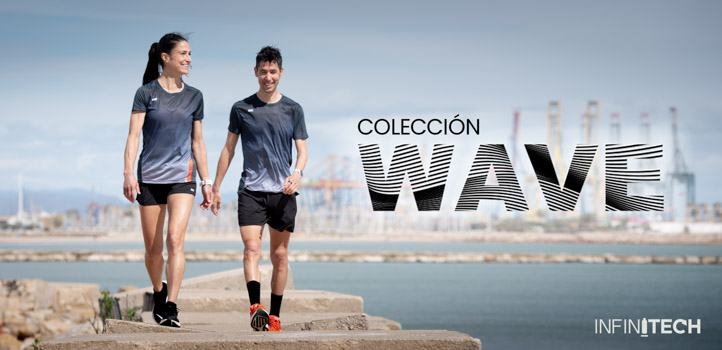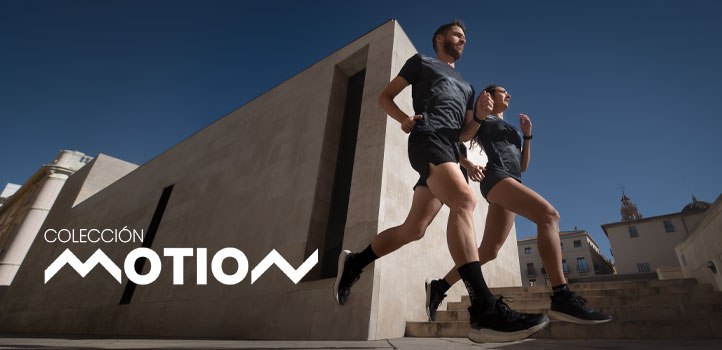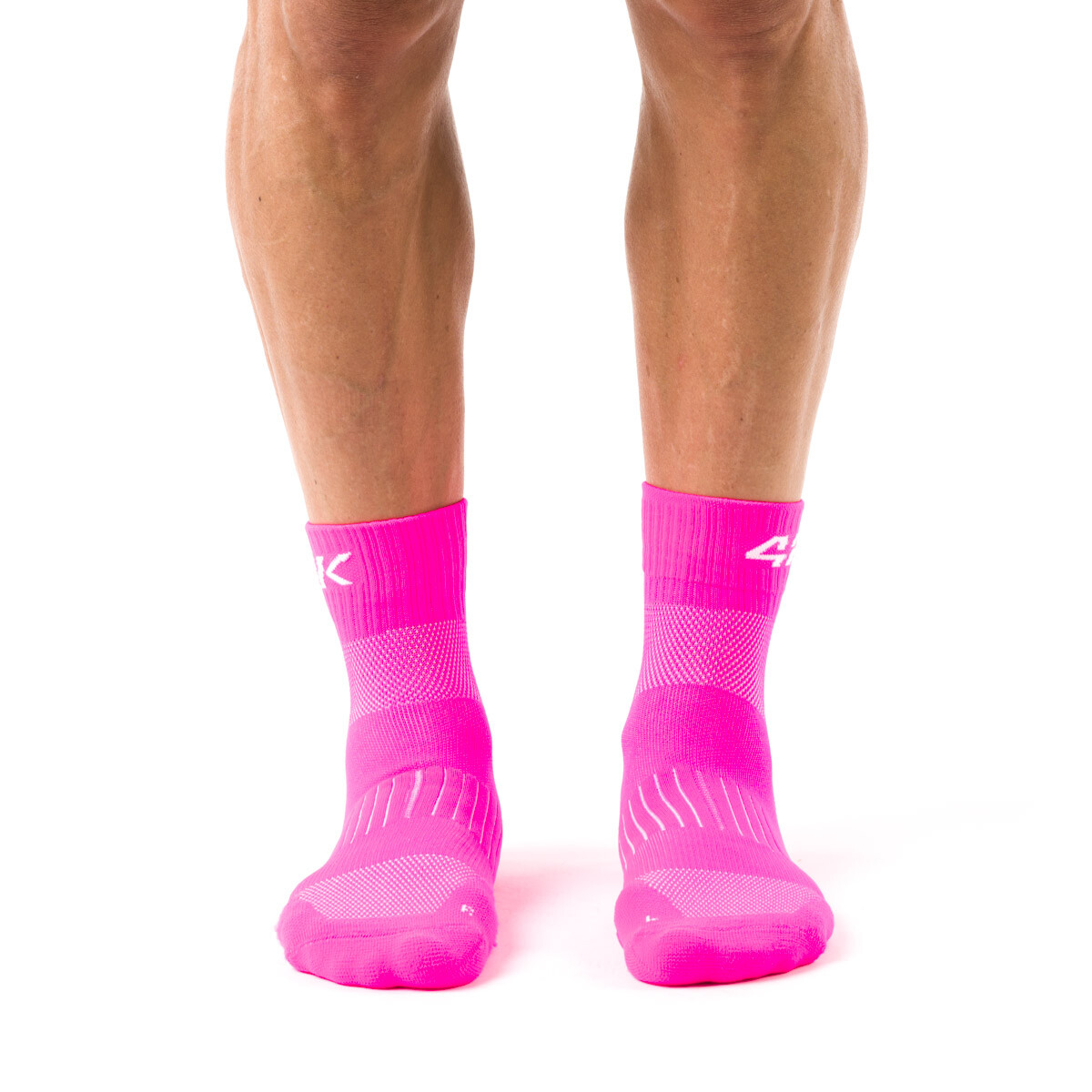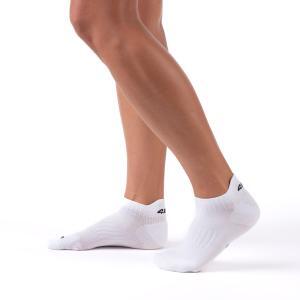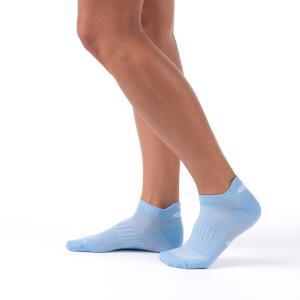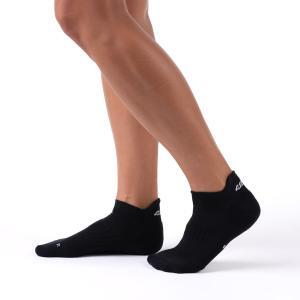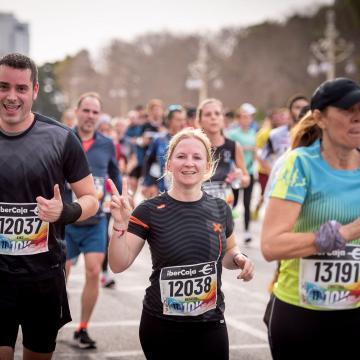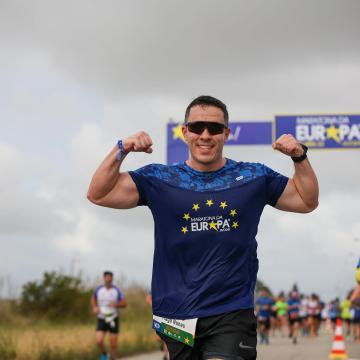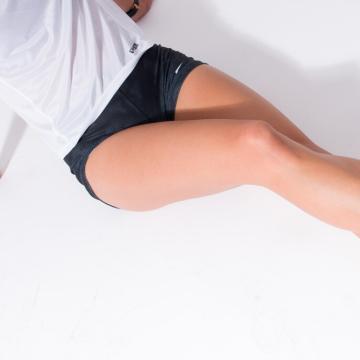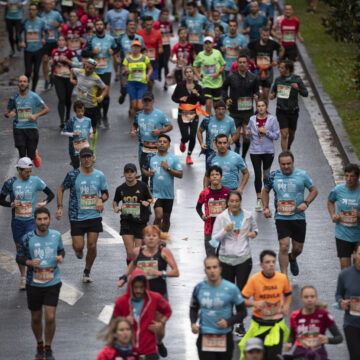Subscribe to our newsletter to find out about all the news and promotions, and automatically receive a welcome discount coupon in your email.
post -> 'Runner's knee', a hip problem
What happens when you go over kilometers in preparation for an important race? Well, you have a good chance of suffering iliotibial band injury or, as it is more commonly known, Runner's knee o runner's belt.
'Runner's knee' or iliotibial band syndrome
I remember that in 2015 I received a phone call on a Wednesday, four days before the Valencia marathon. From the other side of the phone line they told me: “Hello David, I am a friend of Jacob and he told me that you can take away my 'runner's knee' problem for this Sunday when I run the Valencia marathon and I want to make a personal record.”. My answer was the following: “Making a personal best will depend a lot on whether or not you can run on Sunday”.
I immediately called him in for a consultation and found that he had accumulated excessive training, very demanding in terms of mileage; Furthermore, I discovered that he had an excessively valgus knee, with an excessively valgus ankle and a timing incorrect muscle that activated the tensor fasciae latae and contractured it to the point of not being able to run.
I told him that I was going to patch his 'runner's knee' problem to try to enable him to compete on Sunday, although I warned him that I couldn't guarantee that he would be able to finish the race. I decided to do the following treatment:
- Dry needling and electropuncture of the tensor fascia latae.
- A functional knee bandage that will align your knee upon impact.
- An ankle bandage that would prevent excessive valgus generated by the activation of the tensor fascia lata.

I asked him to try running 10 kilometers the next day, Thursday (3 days before the competition) and I told him that if everything went well after that training, he could hope to start the marathon and contemplate the possibility of completing the 42,195 kilometers despite his 'runner's knee' problem.
The next day he went out to train and ended up doing 18 kilometers (and not 10, as I had told him) “because I felt good”. “Will I be able to finish the marathon with this?”, he asked me after confessing that he had done 18 kilometers; my answer was "let's try", without more.
Obviously, he did not know (and I did not tell him) that with each impact the bandages on his knee and ankle would lose effectiveness and that little by little he would have pain again; My hope was that he would be able to get to kilometer 25 without any problem and that from there he would be able to endure the increasing pain that he was going to suffer.
This real situation that I have told (and that has happened to me on more occasions throughout my professional career) is something that sports physios sometimes have to face. And in a situation like this you have to make the decision to do palliative physiotherapy, that is, you have to do whatever it takes so that the athlete can compete, leaving aside the therapeutic physiotherapy that would provide a solution to his problem.
But what is the 'runner's knee' or runner's band?
El runner's knee syndrome o iliotibial band syndrome is a frequent injury in runners with too intense preparations and with accumulation of too many kilometers in their legs.
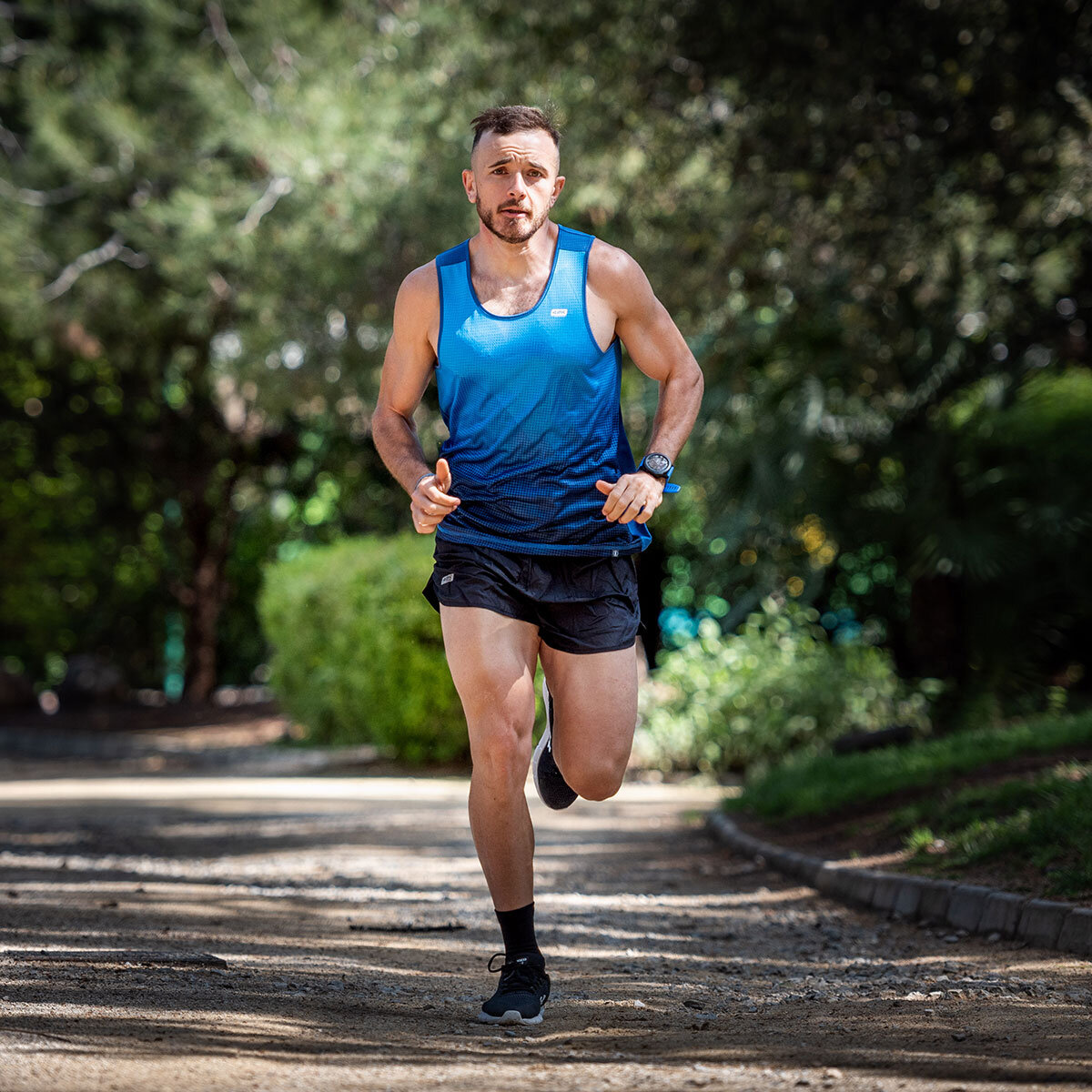
It is an injury that begins with pain on the outside of the knee and it increases progressively, becoming very intense when long runs or training with too many impacts are performed. It's a pain that starts soft and that is increasing until you reach a painful burning sensation that ends up forcing you to stop because the sensation of pain becomes unbearable.
The muscle affected and behind the problem known as 'runner's knee' is the tensor muscle fascia lata; is about a hip muscle with a long tendon that inserts into the knee on its external surface. When the pain begins, it is normal to confuse it with a knee problem, but the problem is really in the hip tensor muscle.
A runner who has a lack of adductor muscles and limitations in the abductor muscles will generate an overload that will cause pain in the knee. This means that if you have more strength in the external part than in the internal part (adduction is what closes the leg and abduction is what opens it), having more strength in the abductor part (the one that opens) will to generate pain in the knee, but really the problem is in the hip.
What should be taken into account when evaluating runner's knee syndrome?
- Weakness in the hip abductor muscles due to overload.
- Runner with poor alignment of the entry of the foot on the ground generating a valgus or varus of the knee, this will cause overstretching or weakness in the tensor fascia latae.
- A runner's short leg will generate a weight shift that will produce more load on one knee; In order not to touch the ground, the athlete has a tendency to run by abducting.
- Excess valgus in the ankles due to loss of strength in the tibialis posterior will force the runner to elevate the foot, generating a poor flight in the stride, forcing the tensor fascia lata to elevate the leg.
- Multidisciplinary work between physiotherapist, physical trainer and podiatrist to generate good biomechanics in the patient.
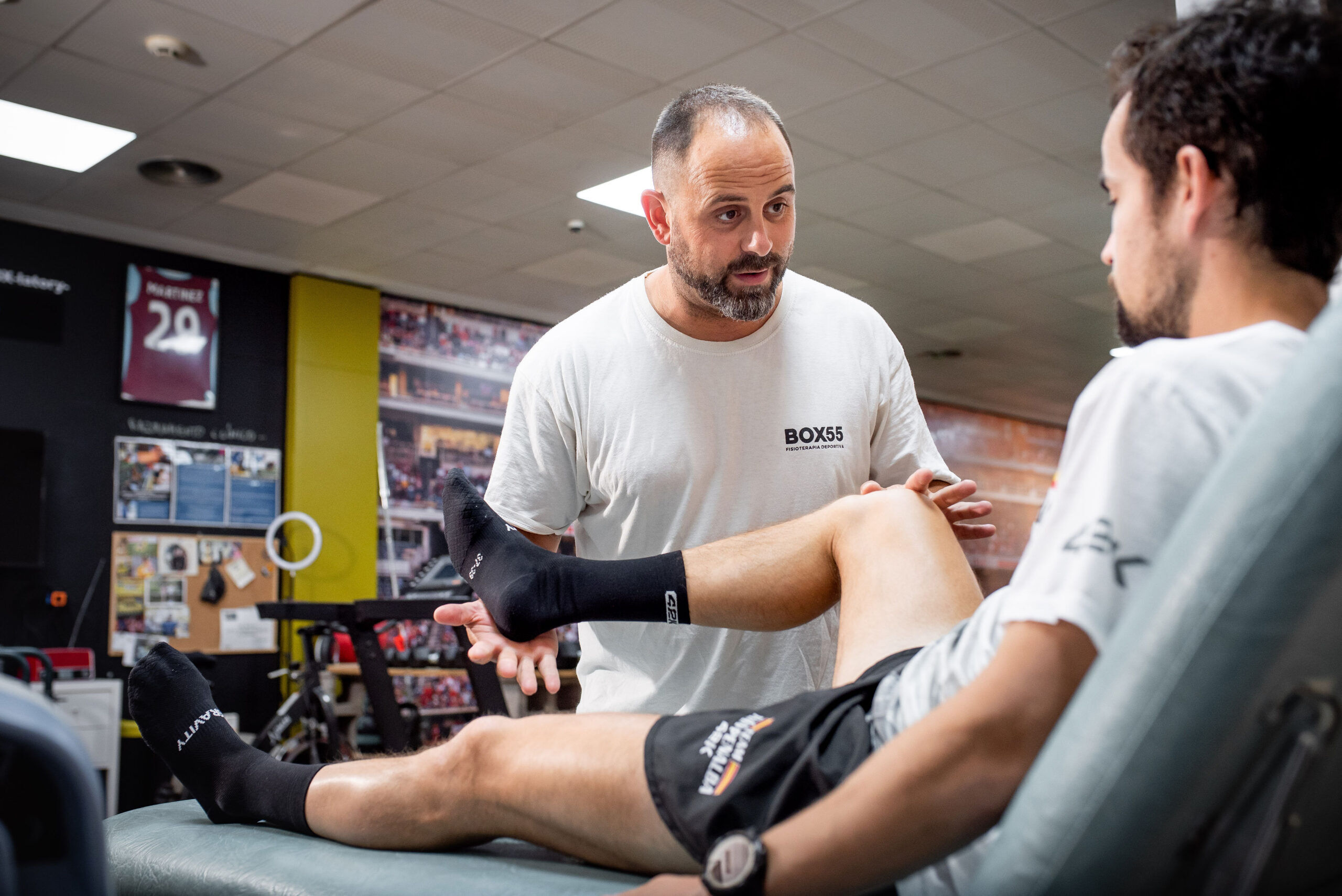
What should you do if you suffer from 'runner's knee'?
- First of all, we must keep in mind that we do work the muscles without control foot posture (foot captor) we will not be able to treat the injury.
- Secondly, we must remember that 'runner's knee' is actually a hip problem so we must improve hip mobility and strength.
- Thirdly, we must control all the strength work of the intrinsic muscles of the foot to improve the adaptation of the knee to the ground.
- Fourthly, we will be forced to do training with fewer kilometers.
- It is advisable to help during rest periods with water training and cycling sessions
- Go to the physiotherapist once a week to improve muscle timming and remove muscle tone.
Going back to the patient from the beginning, he was able to finish the race and even lowered his time from the previous year. When he returned to the clinic on Monday after the marathon, I noticed that his instep was burned and then I asked him what had happened to him and how had he been able to lower his mark?
He told me that at kilometer 15 he had an accident at a refreshment station: «As I approached the aid station I inadvertently stepped on a banana peel, slipped and slipped under the aid station table, knocking all the glasses of water over me. The entire ankle bandage became soaked with water and began to rub after a few kilometers, causing me such pain that I completely forgot about the pain in my knee. In the end, I pushed and ended up sprinting.", he explained smiling to me with his 2nd degree burn on his instep.
Moral: never stop chasing your dreams. In the competition any detail is valid to achieve the objectives. Sport is not healthy, competition is not healthy, but the sports physiotherapist is there to understand you, support you and with a little luck “heal” you.
Today, this patient continues to run marathons with insoles, with less training load and less accumulation of kilometers, with optimal hip activation, with his knee and foot perfectly aligned to be able to enjoy the sport he loves.
Congratulations to all the runners who, against all odds, have the courage to stand at the starting line to try to achieve their sporting challenges; The sports physios will always accompany you.
More articles by David Valenzuela, sports physiotherapist at Box55
Sports physiotherapist David Valenzuela is one of the regular contributors to the blog. 42K. Many long-distance and trail runners pass through his office. running, track, etc., so you know perfectly well what are the main injuries that exist in the world of running, as is the case with the tibial periostitis, Plantar fasciitis, patellar tendinopathy and achilleus tendinopathy, low back pain, hamstring tear or ankle sprain.
- T-shirt technique Woman for running y athletics color coral.
- Technical fabric Tri-Active elaborated with 100% recycled polyester yarn.
- Design with sublimated geometric drawing on the chest.
- Flat seams.
- Printed label Anti-friction.
- Ergonomic front pattern and back panel longer back.
- Seated style sleeve.
- Anti-friction cover seam placket on the neck.
- Logo 42K sublimate.
- Differentiated pattern for runner and runner.
- Treatment for fast dry “DRY-TEC+”.
- Transmission Anti-friction “SOFT-LIGHT”.
- Treatment for color fixation “DC4”.
- T-shirt technique Woman for running y athletics in lilac color.
- Technical fabric Tri-Active elaborated with 100% recycled polyester yarn.
- Design with sublimated geometric drawing on the chest.
- Flat seams.
- Printed label Anti-friction.
- Ergonomic front pattern and back panel longer back.
- Seated style sleeve.
- Anti-friction cover seam placket on the neck.
- Logo 42K sublimate.
- Differentiated pattern for runner and runner.
- Treatment for fast dry “DRY-TEC+”.
- Transmission Anti-friction “SOFT-LIGHT”.
- Treatment for color fixation “DC4”.
- T-shirt technique Woman for running y athletics in white.
- Technical fabric Tri-Active elaborated with 100% recycled polyester yarn.
- Design with sublimated geometric drawing on the chest.
- Flat seams.
- Printed label Anti-friction.
- Ergonomic front pattern and back panel longer back.
- Seated style sleeve.
- Anti-friction cover seam placket on the neck.
- Logo 42K sublimate.
- Differentiated pattern for runner and runner.
- Treatment for fast dry “DRY-TEC+”.
- Transmission Anti-friction “SOFT-LIGHT”.
- Treatment for color fixation “DC4”.
- T-shirt technique Woman for running y athletics in black.
- Technical fabric Tri-Active elaborated with 100% recycled polyester yarn.
- Design with sublimated geometric drawing on the chest.
- Flat seams.
- Printed label Anti-friction.
- Ergonomic front pattern and back panel longer back.
- Seated style sleeve.
- Anti-friction cover seam placket on the neck.
- Logo 42K sublimate.
- Differentiated pattern for runner and runner.
- Treatment for fast dry “DRY-TEC+”.
- Transmission Anti-friction “SOFT-LIGHT”.
- Treatment for color fixation “DC4”.
- T-shirt technique for running y athletics in lilac color.
- Technical fabric Tri-Active elaborated with 100% recycled polyester yarn.
- Design with sublimated geometric drawing on the chest.
- Flat seams.
- Printed label Anti-friction.
- Ergonomic front pattern and back panel longer back.
- Seated style sleeve.
- Anti-friction cover seam placket on the neck.
- Logo 42K sublimate.
- Differentiated pattern for male and female runners.
- Treatment for fast dry “DRY-TEC+”.
- Transmission Anti-friction “SOFT-LIGHT”.
- Treatment for color fixation “DC4”.
- T-shirt technique for running y athletics color coral.
- Technical fabric Tri-Active elaborated with 100% recycled polyester yarn.
- Design with sublimated geometric drawing on the chest.
- Flat seams.
- Printed label Anti-friction.
- Ergonomic front pattern and back panel longer back.
- Seated style sleeve.
- Anti-friction cover seam placket on the neck.
- Logo 42K sublimate.
- Differentiated pattern for male and female runners.
- Treatment for fast dry “DRY-TEC+”.
- Transmission Anti-friction “SOFT-LIGHT”.
- Treatment for color fixation “DC4”.
- T-shirt technique for running y athletics in white.
- Technical fabric Tri-Active elaborated with 100% recycled polyester yarn.
- Design with sublimated geometric drawing on the chest.
- Flat seams.
- Printed label Anti-friction.
- Ergonomic front pattern and back panel longer back.
- Seated style sleeve.
- Anti-friction cover seam placket on the neck.
- Logo 42K sublimate.
- Differentiated pattern for male and female runners.
- Treatment for fast dry “DRY-TEC+”.
- Transmission Anti-friction “SOFT-LIGHT”.
- Treatment for color fixation “DC4”.
In strength training you must also include basic strength exercises for top train and trunk. It is a mistake not to work the large muscles of the trunk because they are also necessary to achieve maximum efficiency as a runner. In this article we are going to present 5 basic strength exercises for upper body and trunk his recommended for runners; it is about the Push-ups, rowing, el shoulder press, bicep curls and triceps dip.
The trainer and physical trainer Marcos Greus (INEF graduate specialized in high performance) explains in the following article and also through a video how to correctly perform these five basic strength exercises for the upper body. “They are five basic exercises but with which you can work all the large muscles of the upper part of the body or what is also called the upper body”says Greus.
Basic strength exercises for pectoral, dorsal, shoulders and arms
Too often we coaches come across runners who do not give the importance it really has to upper body strength work. To improve as a runner it is essential work strength evenly. It is a mistake to think that to progress in running It is enough to do strength work for the legs. The main objective of strength sessions is to gain power and endurance to perform better and avoid injuries.
El strength training It is important for the entire population, but it is fundamental and indispensable for people who run regularly.
Strength work on the lower body (legs) should be a priority, but it cannot be isolated; you also have to work core (abs, lower back muscles and hip muscles) and of course also the upper body in a suitable way to avoid muscle imbalances.
When starting to run, it is common to have doubts about which basic strength exercises are the most appropriate. In other articles on this blog there is information about the main strength exercises for legs and also about basic exercises to work the core, so now we are going to see what are the basic strength exercises for the upper body, that is, for the pectoral, dorsal, shoulders and arms.
There are many valid exercises to gain strength in the upper body, but I consider it appropriate to recommend those that encompass extensive work of the large muscle groups of the upper part of the trunk; namely:
- Pushups to work the pectoral.
- Remo to work the dorsal.
- Shoulder press to work the deltoid.
- curl de biceps.
- Funds to work the Triceps.
These 5 basic strength exercises for the upper body guarantee complete work and are optimal for people who are starting out running or who have been running for some time and have not yet incorporated strength work into their training.
Any of these exercises can be done at home and we will only need some elastic bands or weights (weights can also be used, but it is advisable not to abuse weights that prevent the exercises from being performed correctly).
Basic strength exercises for the upper body: 1. Push-ups
To work the pectoralis major and minor area, I recommend using push-ups. This is a basic self-loading exercise in which your own weight is used.
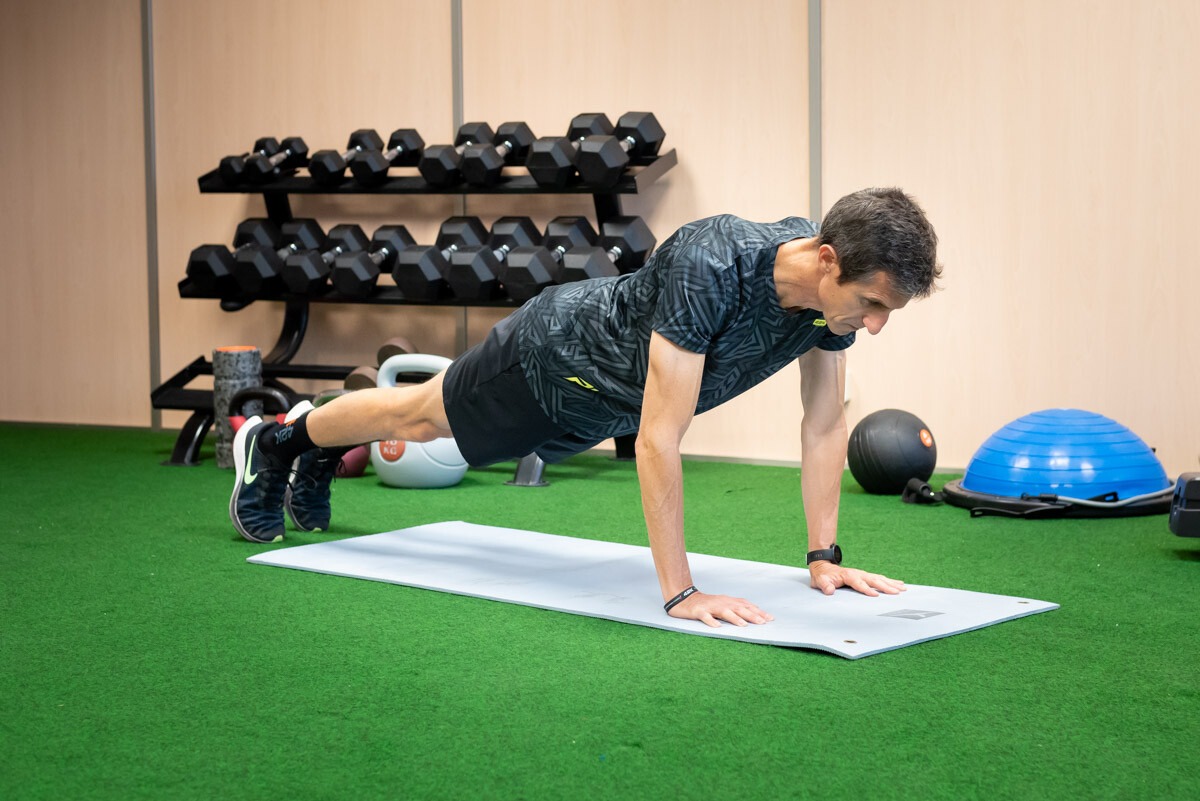
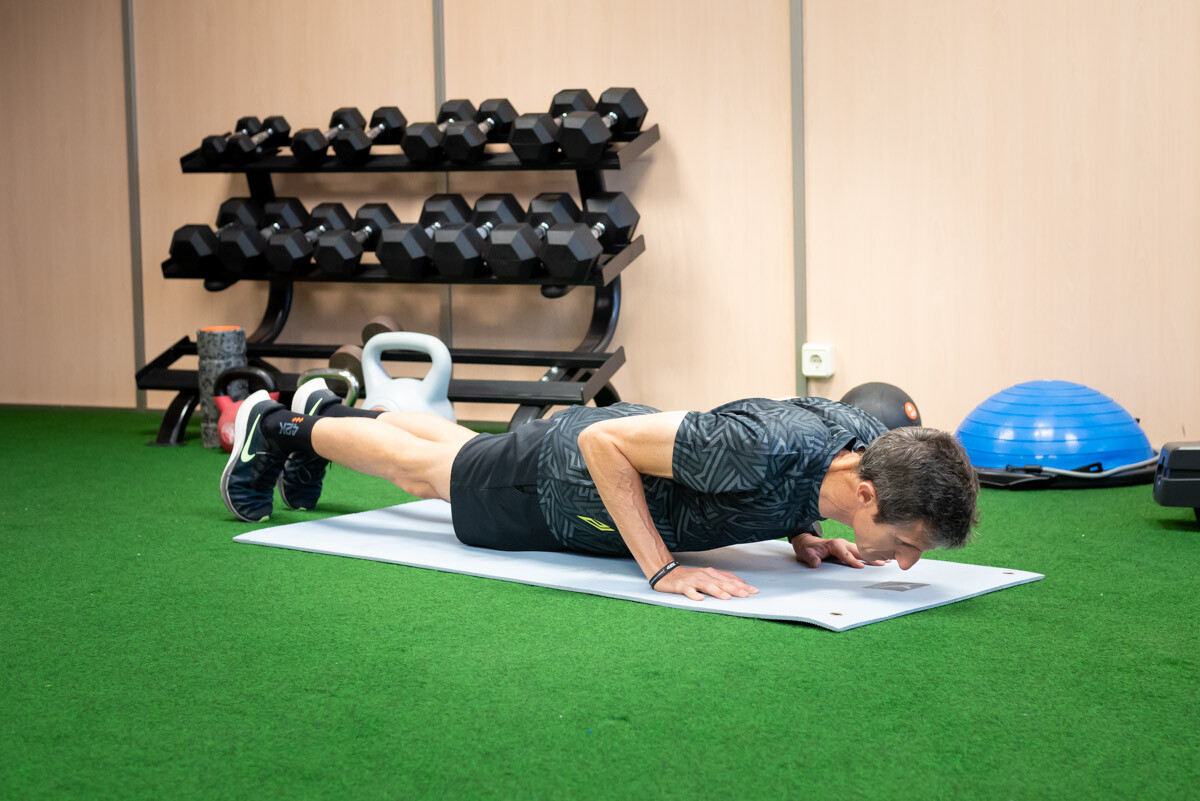
Aspects to take into account for correct performance of the push-up:
- Starting position: lying face down with the trunk simulating an iron from head to toe, placing the hands with a separation similar to that of the shoulders and below them.
- Contract glutes and abdominal girdle before starting the descent.
- Feet together or with a minimum separation to keep the glutes tense.
- In the lowering phase (eccentric) the elbows bent backwards.
- The chest should not come to rest or touch the floor.
- Push phase to the starting position with full extension of arms and shoulder.
- El timing Each push-up should be 3 seconds: 1 second to go down, 1 second to hold at the end of the descent and 1 second to go up.
Benefits of push-ups:
- It is an exercise that activates and works different muscles at the same time, with special strengthening of the chest and arms (biceps and triceps); The deltoids, abdominals, quadriceps and glutes are also activated.
- Increased upper body strength and power.
- It strengthens the spine and the trunk in general, which promotes an improvement in body posture.
- Core reinforcement. Push-ups activate the abdominal muscles and back muscles, which in addition to influencing better back posture also reduces the risk of discomfort or pain that the running may cause.
Basic strength exercises for the upper body: 2. Rowing
The second of the basic strength exercises for the upper body is rowing. Rowing works an important part of the back: latissimus dorsi, shoulder girdle, trapeze… For this exercise we can use an elastic strength band or rubber band (it can also be done with weights).
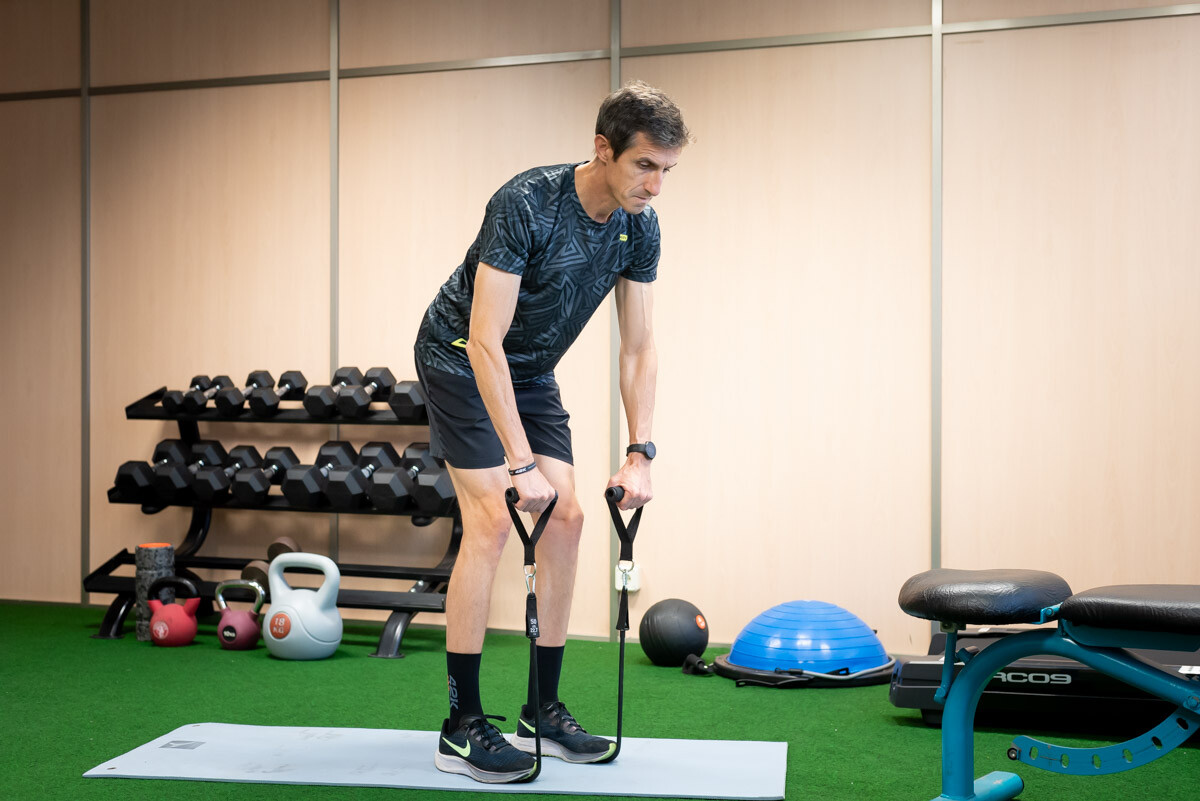
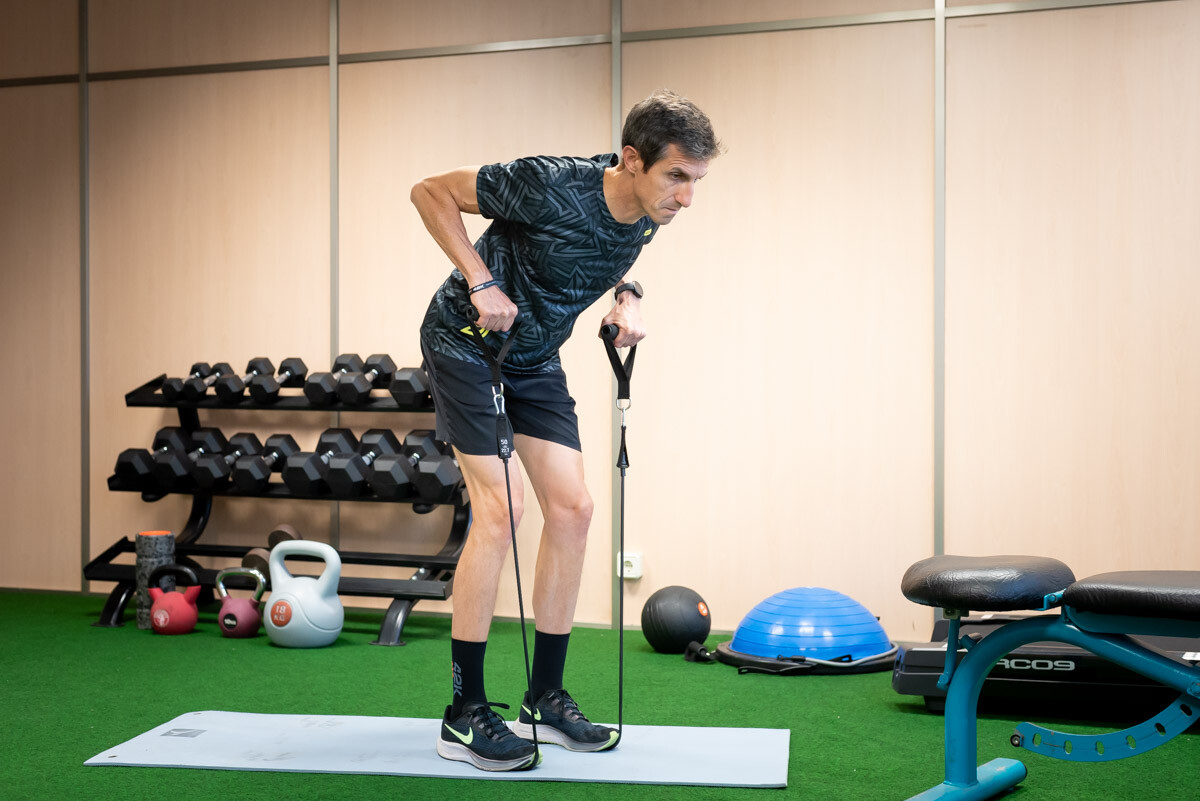
Aspects to take into account for correct rowing:
- Initial position: we start from a hip flexion but without curving the back and without having the shoulders forward.
- The arms they work close to the body (do not push them away) and always doing the movements in a controlled manner.
- El timing This exercise should last 3 seconds: 1 second when flexing, 1 second for maintenance and 1 second for extension.
Benefits of rowing:
- Strengthening the back.
- Improved back posture, which undoubtedly helps avoid back pain and possible injuries.
Basic strength exercises for the upper body: 3. Shoulder press/military press
The third of the basic strength exercises for the upper body is the shoulder press or the military press. The shoulder press allows us work the entire deltoid area (both the long, middle and short heads of the deltoid). For this exercise we can use an elastic strength band or rubber band and it can also be done with weights; If we use weights, we must be careful to use a weight that allows us to perform the exercise correctly without imbalances and without the need to bend or tilt the back. Using inappropriate weights that are excessive can be dangerous in most exercises, but especially in the shoulder press because it will force us to make sudden movements that can be dangerous.
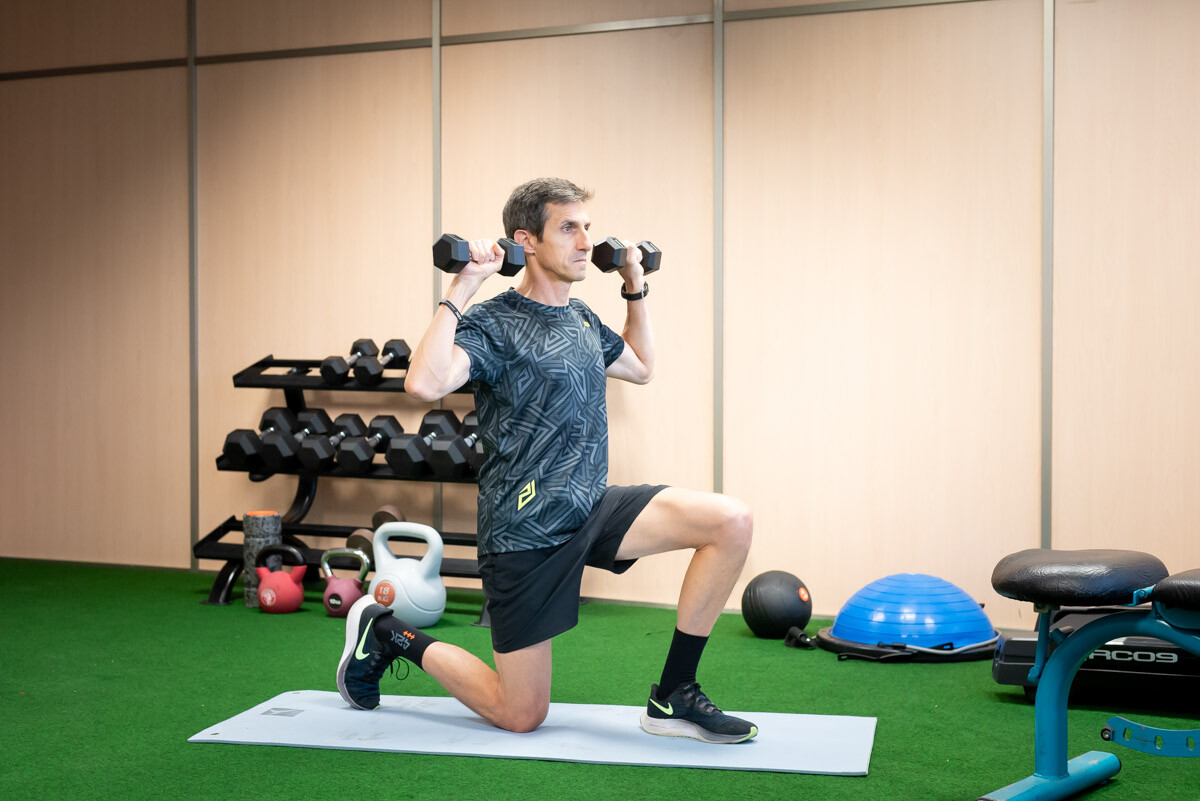
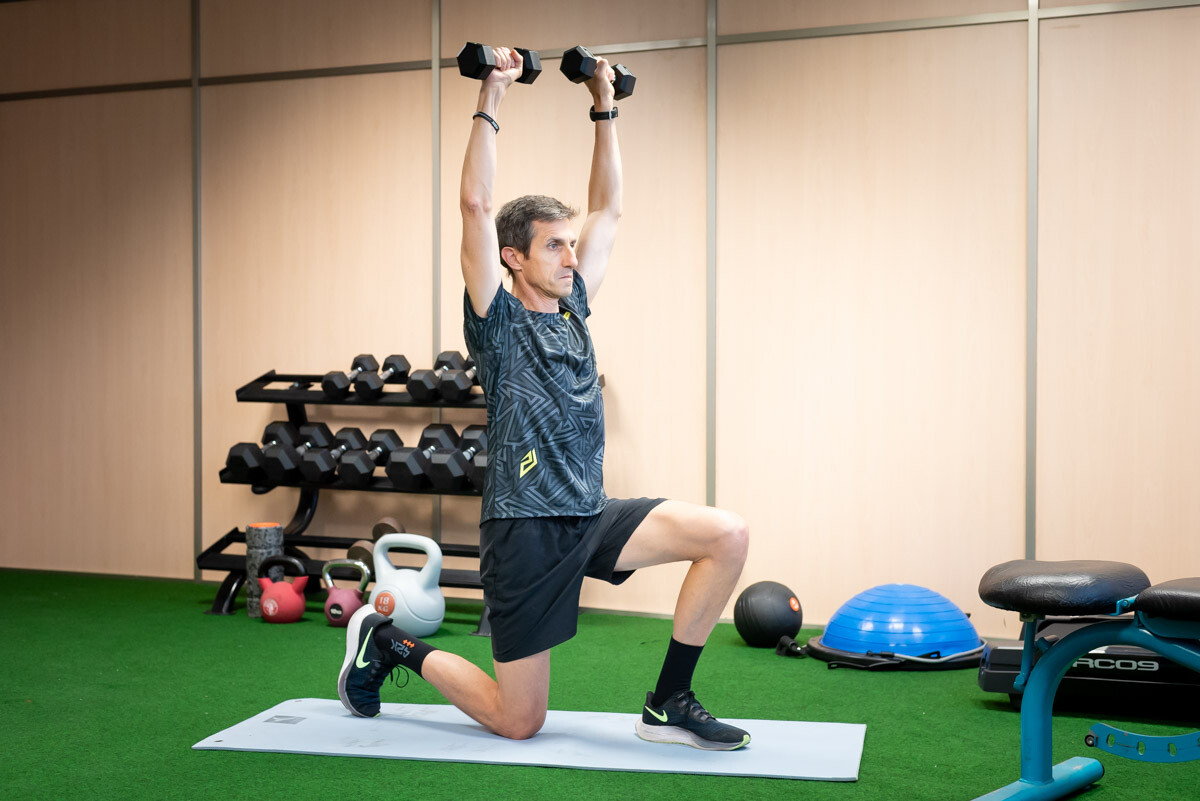
Aspects to take into account for correct performance of the shoulder press/military press:
- Starting position: with perfectly straight back We will place our hands at shoulder height, ensuring that the hands are placed with the palms facing forward on the sides of the body.
- The lifting must be carried out in such a way that the hands stay vertical on the shoulders.
- Always use appropriate resistance (if using elastic bands) or weights (if using dumbbells) and do not work by forcing this musculature.
- Doing good use of breathing: Inhale when lifting and exhale when descending.
- El timing This exercise should last 3 seconds: 1 second when raising the arms, 1 second for maintenance and 1 second for descent.
Benefits of the shoulder press:
- Strengthening the shoulders, very important muscles for the arm stability.
- Increased muscle strength and bone density.
- Improvement of body coordination and arm stability for day-to-day actions.
Basic strength exercises for the upper body: 4. Biceps curl
The fourth of the basic strength exercises for the upper body is the biceps curl. There are many exercises that will allow us to work the biceps but we are going to use the simplest and most classic which is the biceps curl.
To improve as a runner it is necessary to strengthen the legs but it is also important to work on the strength of the arms, because the arms are decisive for running more efficiently. With strong arms (we are not thinking about biceps hypertrophy, but rather having toned arms) you can improve your running posture and obtain greater balance to improve speed and endurance.

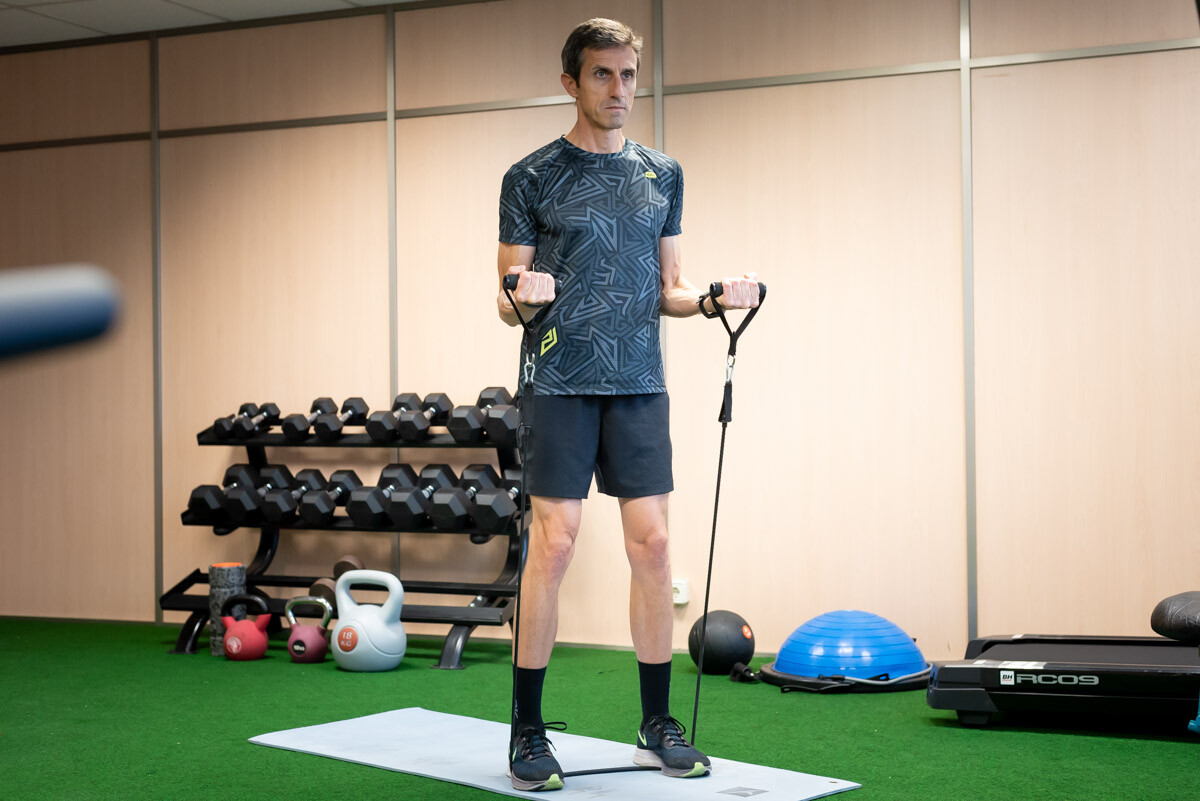

Aspects to take into account for correctly performing the biceps curl:
- Starting position: standing, with a small semi-flexion in the legs, elbows stuck to the sides and completely straight back.
- It can be done with elastic bands or with two dumbbells (I do not recommend the use of a bar for those who are starting to do this exercise). In both cases you can perform the exercise by raising your arms at the same time or alternately.
- It is advisable to start with your palms parallel to your body and make a small twist during the lift while contracting your biceps.
- Doing good use of breathing: Inhale when lowering and exhale when lifting.
- Search not swing during the exercise.
- El timing This exercise should last 3 seconds: 1 second when lifting, 1 second for maintenance and 1 second for descent.
Benefits of bicep curls:
- Increased strength and therefore the ability to perform daily tasks that involve lifting and pulling.
- Increased balance and stability when running, since it also involves work on the stabilizing muscles of the core and legs.
Basic strength exercises for the upper body: 5. Triceps dips
The fifth of the basic strength exercises for the upper body is triceps dips, which, like push-ups, is a self-loading exercise (with the weight of the body). This exercise is highly effective and provides many benefits, but it is perhaps the most demanding of the five basic strength exercises for the upper body. It is very important to do it correctly and as a first step it is necessary to do a good warm-up, especially of the shoulders.
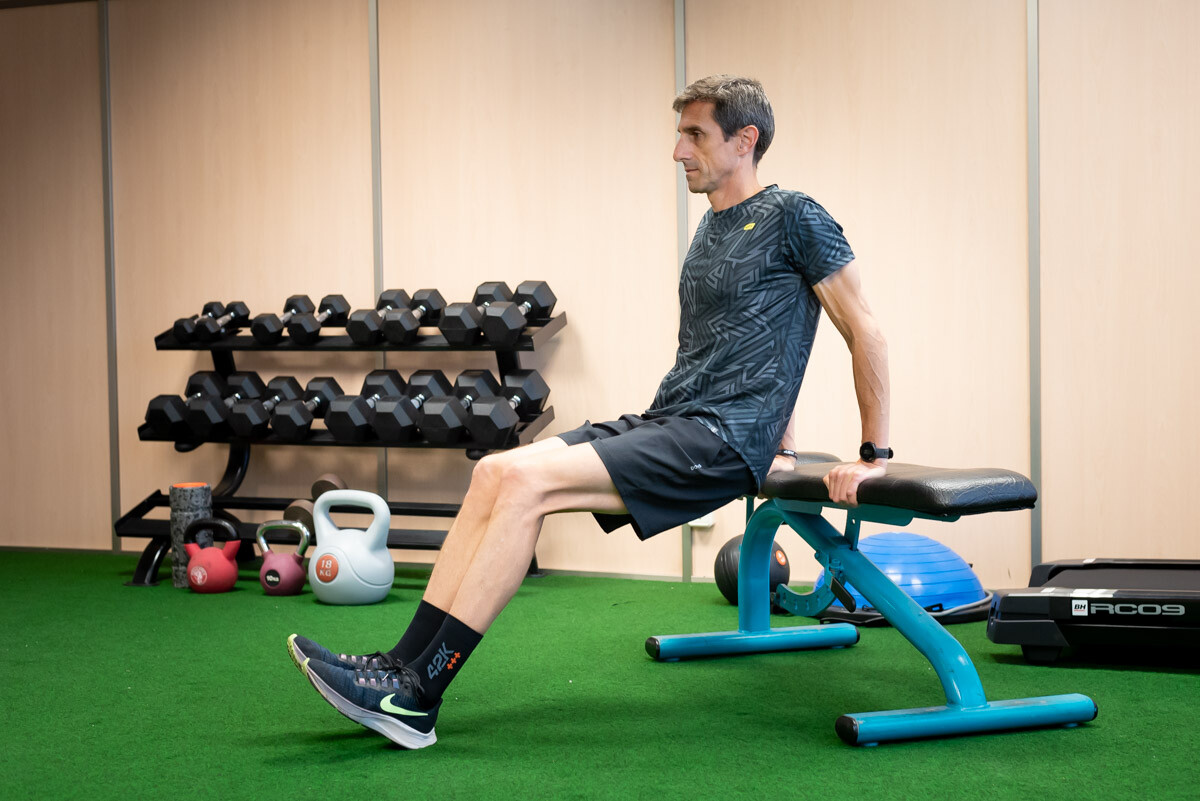
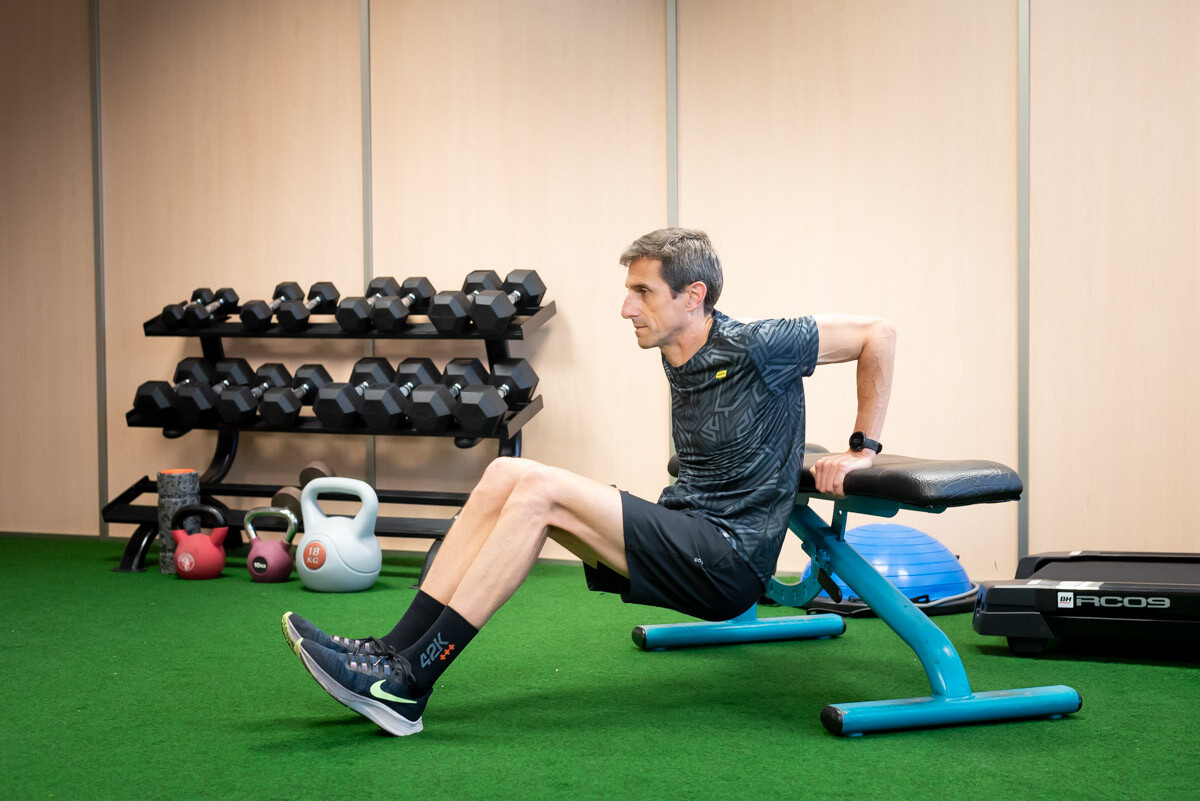
Aspects to take into account for correctly performing the biceps curl:
- Starting position: use a bench, a chair or a fitball to support your hands, with a separation approximately the width of your shoulders (avoid a separation of your hands that is too narrow or too wide).
- From the initial position, with your arms fully extended, you must lower your body in a controlled manner until the upper part of your arm is parallel to the ground; From there it is pushed to the initial position.
- Doing good use of breathing: Inhale when lowering and exhale when lifting.
- Avoid rocking during the exercise.
- Avoid going too low.
- El timing This exercise should last 3 seconds: 1 second when lifting, 1 second for maintenance and 1 second for descent.
Benefits of triceps dips:
- Increased strength and joint mobility of the arms.
- Increased balance and stability when running.
- Improvement of shoulder mobility since it also provides effective work for the deltoid and even the pectoral muscles.
How to perform these basic strength exercises for the upper body?
Now you know how to perform the 5 basic strength exercises for the upper body, but how often?
For people starting out with strength work, my recommendation would be to do 1 sets of 3 repetitions once a week. In the case of runners who have already done strength work, my recommendation would be to perform these exercises doing 15/2 sets of 3 repetitions twice a week.
42K has renewed its entire socks catalog running with 3 new collections in three different measures: 22 cms, 14 cms y ankle braces.
Three new collections of technical socks from running and multisport to satisfy all tastes of cane heights: Ingravity2 (22 cm), Etna2 (14cms) y Low Run (ankles).
Socks running with three shaft heights
The socks catalog running 42K has grown with the incorporation of three new collections different in terms of style and shaft height, but with a common denominator: excellent technical quality at an unbeatable price.
All socks 42K They are designed and developed to meet the expectations of the most demanding runners. Like all products 42K They have been tested in different terrains, distances (races and/or training from 1 hour to 5 hours) and circumstances (different intensities and rhythms; in heat and cold...) by runners of 42K to verify that its performance is optimal.
Ingravity2, socks running high cane
The Ingravity2 It is designed for those runners who are looking for socks. running de tall cane with minimalist design discreet colors. They have 22 centimeters of shaft height and offer maximum comfort for running, triathlon, cycling or Nordic walking.
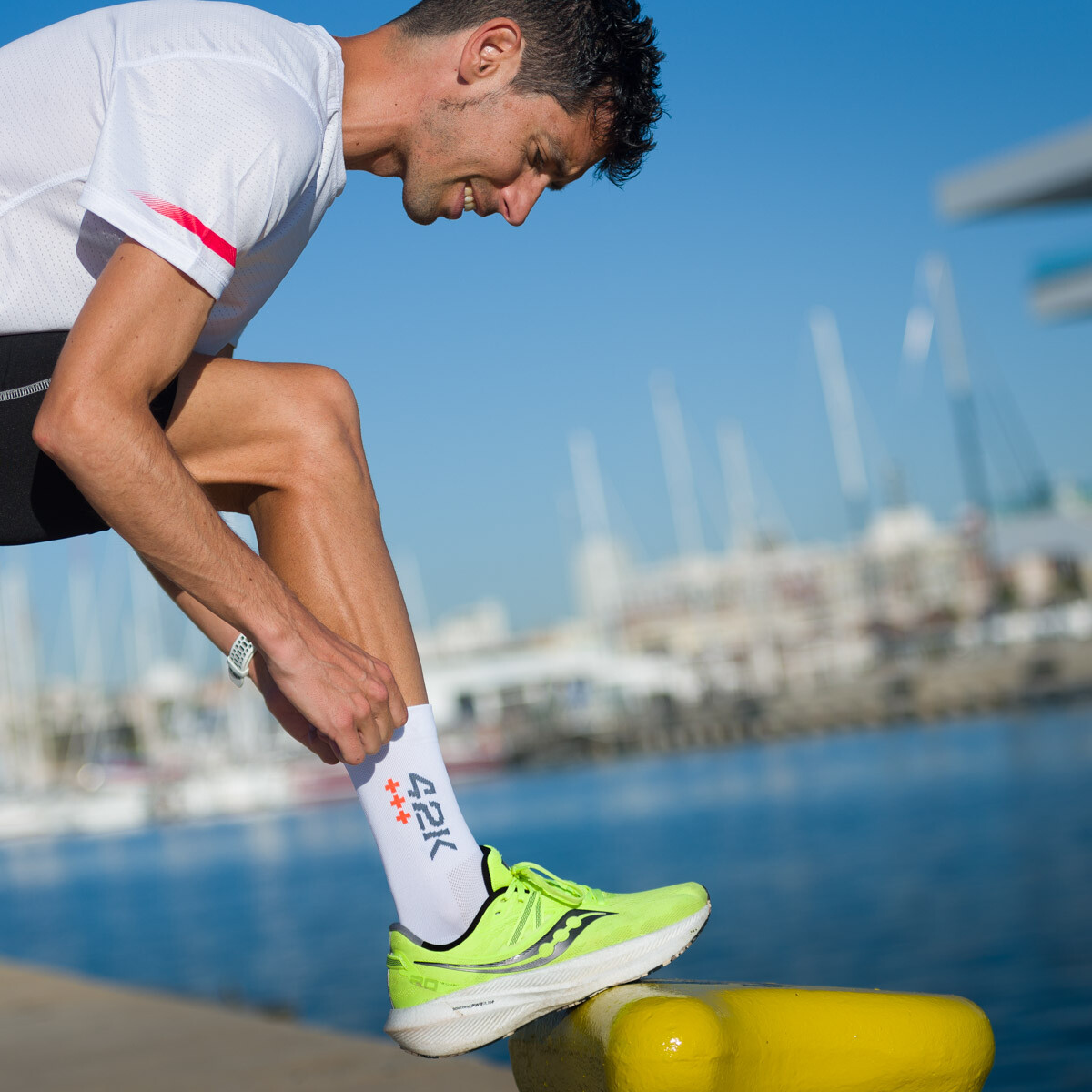
Its fabric and design make it feel like a second skin thanks to its semi-compressive fit. guaranteesn a excellent performance during sports practice, both in short distances and in long runs, standing out for its comfort, breathability and durability.
The Ingravity2 are manufactured with VAPORFEEL PURE®, a material of high resistance to abrasion and impacts which makes them very durable. Another of its properties is that it transports moisture to the outside and keeps your feet dry. In addition, VAPORFEEL PURE® incorporates bactericidal action and antimicrobial which neutralizes possible discomfort and bad odors caused by bacteria and fungi on the skin.

Another of the singularities of this collection is that it incorporates a new treatment grip which favors the anti-slip of the foot
The Ingravity2 wear the logo 42K embroidery on the exterior side and are available in four colors: navy (blue), black, white y grey.
with these socks running Some of our athletes have already competed in long-distance events, such as Carmen Pérez and Sete Cerdán, in the demanding Climb to Pico Veleta (Carmen was the female winner), a 50-kilometer (+2.705m) test in the socks Ingravity2 demonstrated magnificent performance during the almost 5 hours of racing in the middle of August and on the hot Granada asphalt.

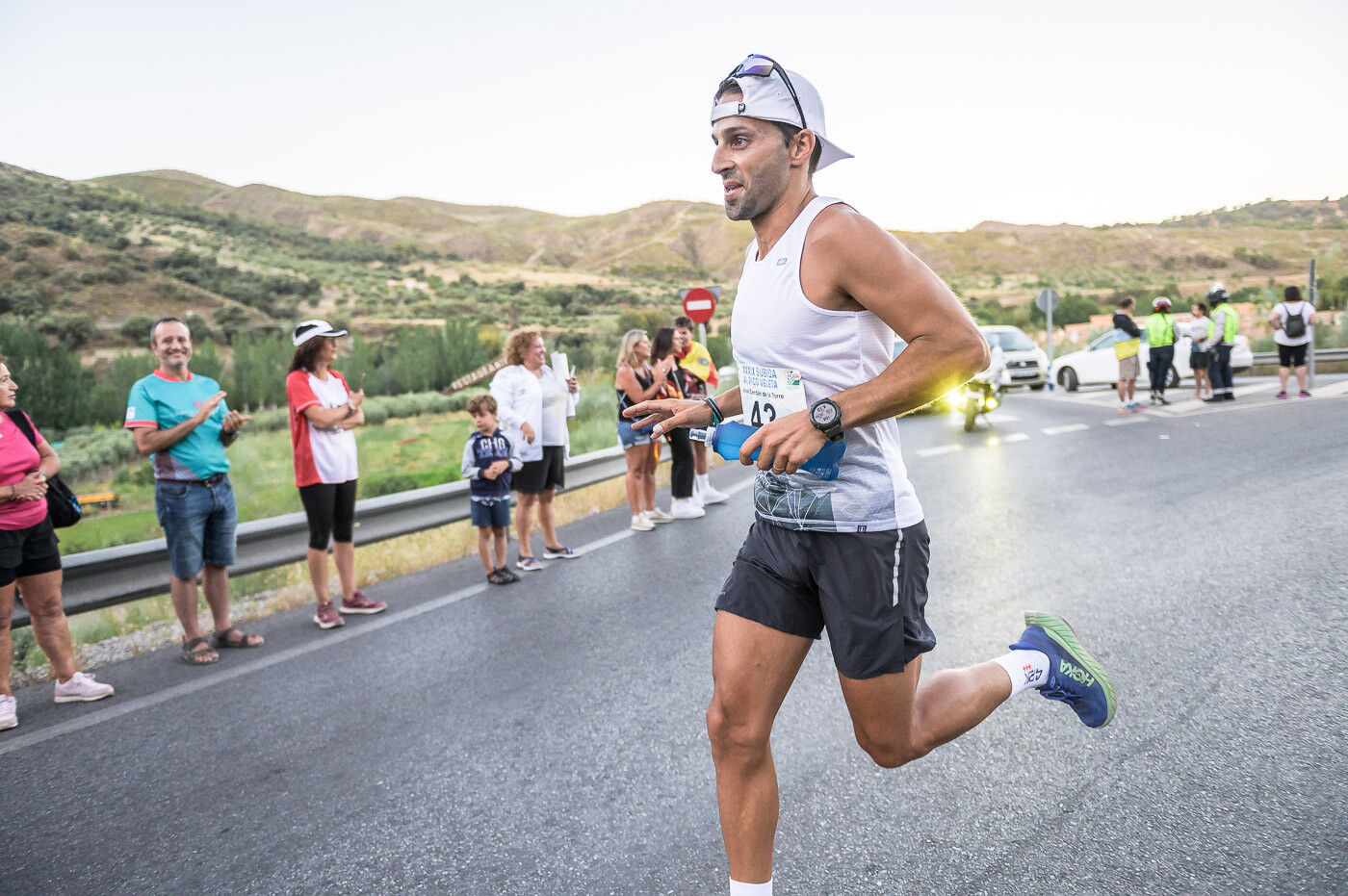
Etna2, socks running 14 cm
A few years ago we named one of the most successful collections of technical socks after the famous Sicilian volcano Etna. 42K.
The etna2 They are a total renewal of the successful Etna sock by 14 cms and are perfect for runners, both on asphalt and in the mountains, who want a high-performance technical sock of Average height y semi-compressive fit.
New ones have been incorporated into the Etna2 fluorine colors for those runners who want to put a striking splash of color to your strides, although they are also available in black and white for more classic runners.
The main improvement and novelty of the Etna2 is the preparation with VAPORFEEL®, a material used by some of the most important sports brands on the market to manufacture high-performance technical socks.
The thermal properties of VAPORFEEL® (especially optimal for humid climates) facilitate the transport of the sweat to the outside which helps keep feet dry, minimizing the risk of blisters and ensuring a high level of comfort in all types of training or short, medium and long distance races.
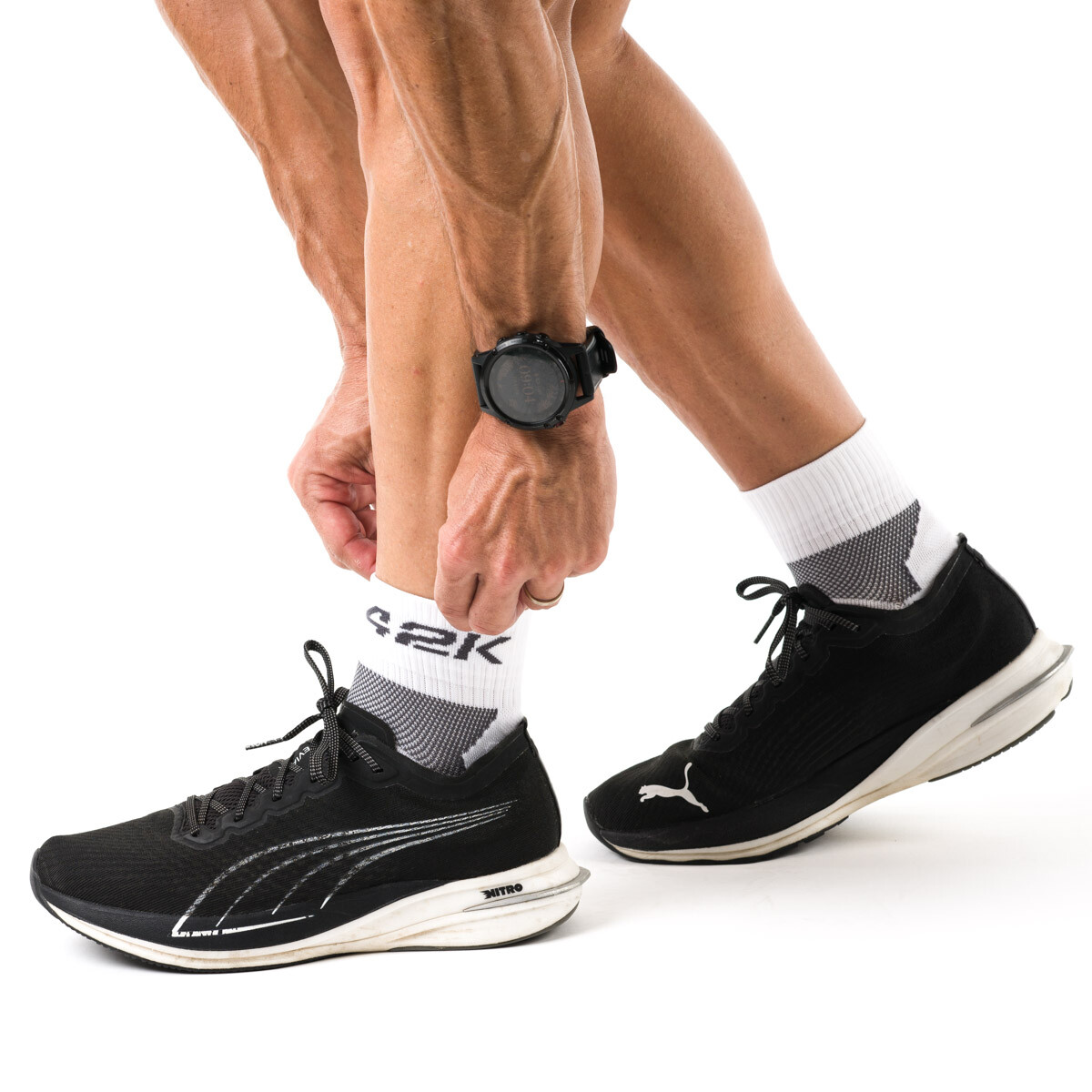
This material allows us to create technical socks that are perfect for intensive practice of running in hot or humid environments thanks to its optimal sweat evacuation capacity.
Incorporate reinforcements and specially padded areas en toecap, metatarsals, heel y Achilles tendon to provide protection and cushioning to the parts of the foot that can suffer the most during running.
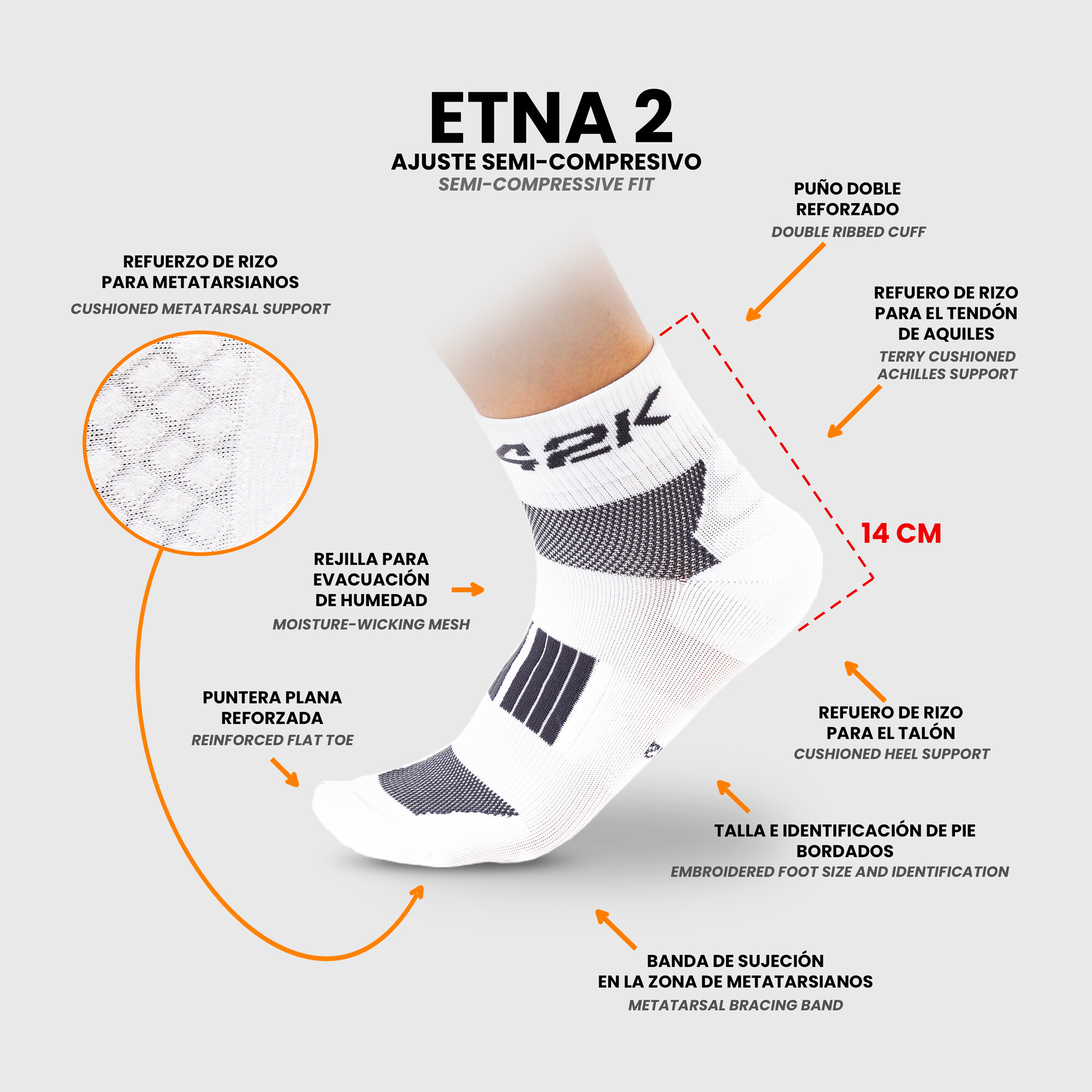
The Etna2 collection is made up of five colors: three fluorine (pink, yellow y orange), white y black.
Low Run, socks running ankle braces
The Low Run is the latest to join the catalog of technical socks for running and multisport 42K.
These are ankle socks fine tissueThanks to its 1 thread sewing, and are ideal for runners who want a light sock almost invisible that feels like a second skin.
The height of the shaft is at ankle level to offer protection against any possible friction with the collar of the shoe and on the back it has a special tab to avoid discomfort with the buttress.
Like the Etna2 collection, they are made with VAPORFEEL®, a high-density material that stands out for its lightness and resistance to abrasion, with optimal thermal properties for humid climates by transporting sweat to the outside and keeping feet dry to reduce the risk of blisters forming.
they have reinforcements and terry zones specially padded in the required areas (toe, sole and heel) to avoid discomfort from chafing.

The Low Run collection is made up of 3 colors: white, black y light sky blue.
The importance of good socks running
Choosing good technical socks is the best guarantee to enjoy the running. People who are starting out in the world of running They mistakenly believe that any sports sock is valid for running and that is not the case. The choice of Inappropriate sports socks can cause problems (irritations, chafing and even blisters) if used for regular running or long-term training.
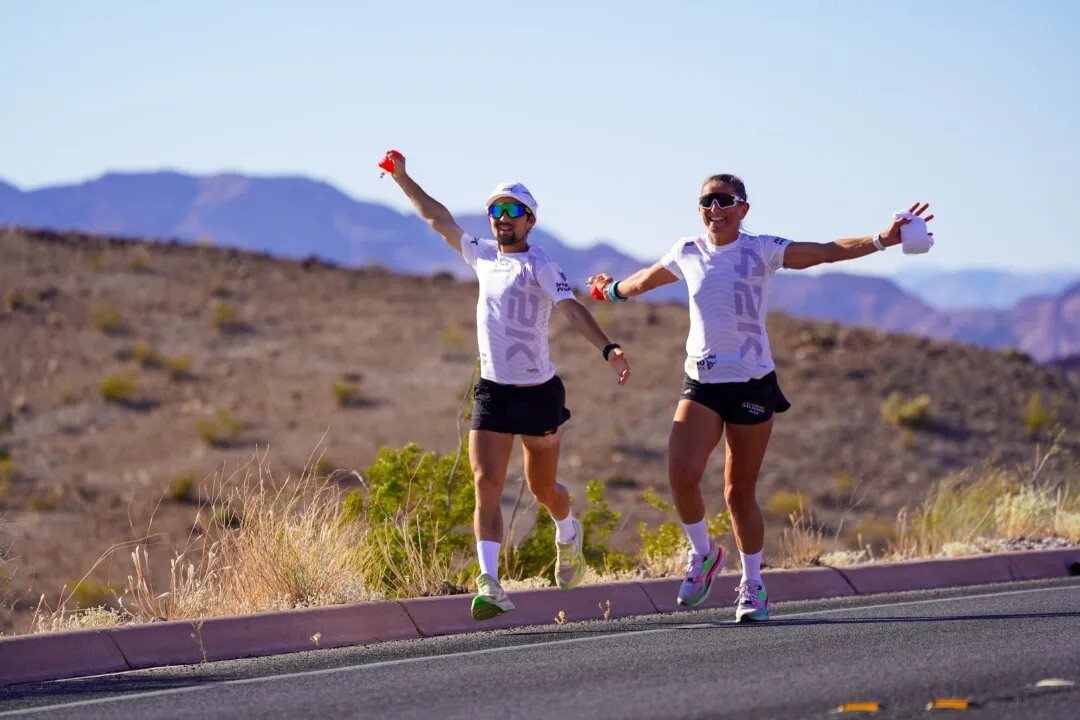
As we explain in another article on this blog titled Technical clothing to start running, the feet are one of the parts of the body that any runner must especially take care of and that is why the correct choice of specific socks for them is so important. running.
A Pair of healthy and problem-free feet They are necessary in any sport that involves running, but it is essential when the sport being performed is running.
And to enjoy the running With healthy feet you have to choose the appropriate technical material in terms of shoes and socks. In the case of choosing socks running You have to make sure that they guarantee good grip y protection of the most delicate areas of the foot, as well as correct evacuation of sweat to the outside to avoid risks of irritation or softening of the skin.
42K commitment to the preparation of its different collections of socks running by high-quality technical fabrics that stand out for their qualities of elasticity and fit, breathability (important in any sports sock, but essential in a sock for running) Y durability.
Socks running made in Spain
All socks running 42K are made in Spain and are offered in savings-packs that allow their purchase with a 10% discount on the unit price.
Fartlek It is one of the terms that is part of the universal language of running. Fartlek is a swedish word which means “speed game” and give name to resistance training method developed by Swedish coaches Gösse Holmer and Gösta Olander in the 30s
Almost one hundred years after its implementation, this training method continues to be widely used in athletics and also in sports. running popular.
In this article we are going to analyze the benefits of fartlek, how to do it and what it is for.
Fartlek or variable continuous training
Resistance training methods can be grouped into two types: constant continuous training y variable continuous training (fartlek). Continuous training is characterized by no recovery breaks.
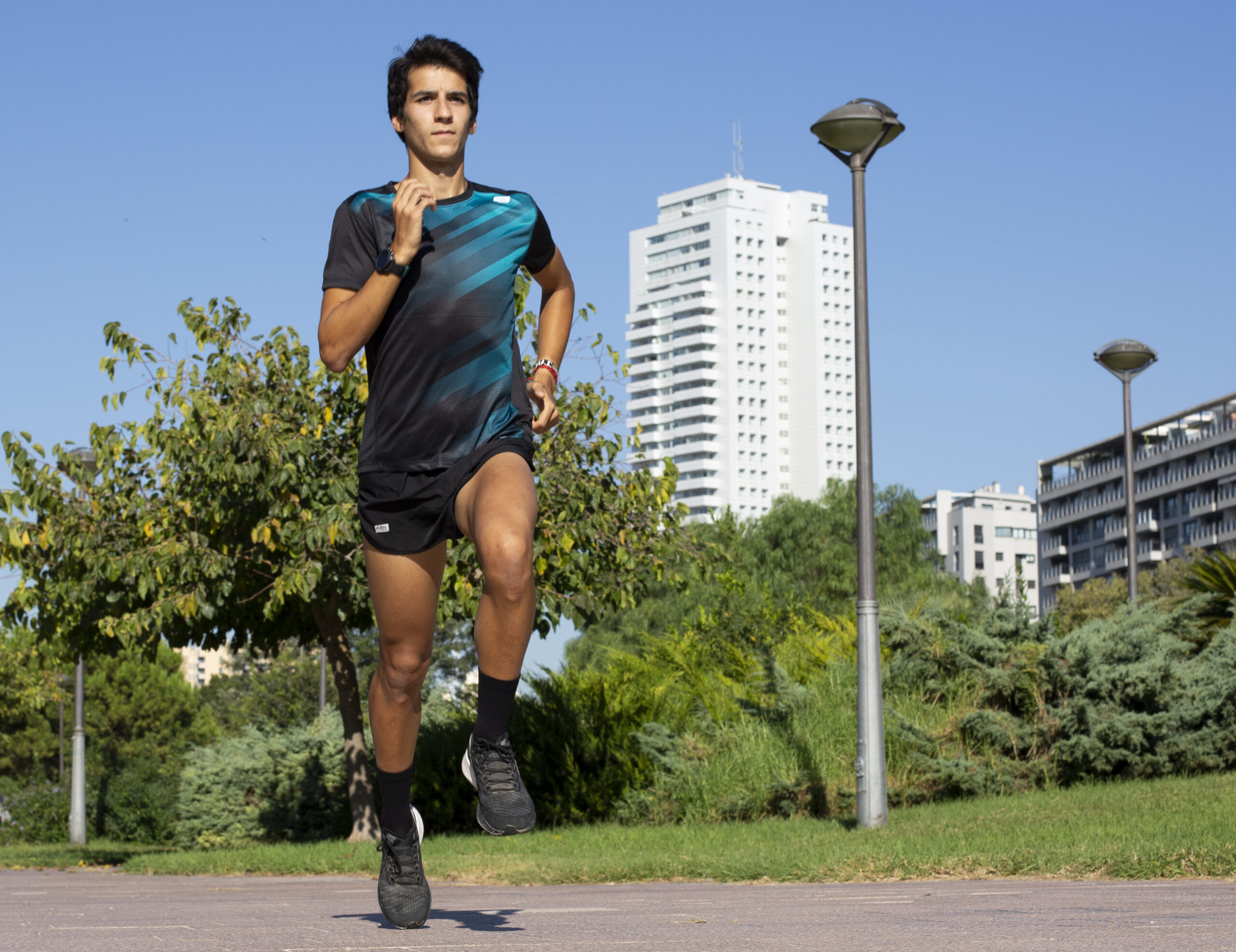
The training continuous constant serves to improve the aerobic resistance and, in summary, it consists of traveling a long distance (more than 30 minutes of continuous running) at constant intensity, no change of pace and without taking recovery breaks.
The training continuous variable or fartlek, instead, introduce changes of rhythm which can be forced by the terrain or the speed of the runner. That 'adaptability' to changes of pace is why its creators baptized it as a “speed game” (fartlek).
Fartlek is a highly effective and versatile training method, used in the running to improve la resistance, speed and aerobic capacity.
This type of training combines intensity intervals with lower intensity recovery periods; Depending on the level of the runner, recovery can be done by running or walking.
It is a training in which there are no breaks for recovery; You do not stop running and alternate changes of pace (it can also be done using ''CA-CO'', which is WALKING and RUN; this option is the most recommended for beginner runners or for runners who are returning after a long time break due to injury, illness...), it can also be done on varied terrain, which makes it a powerful tool for runners of all levels.
Benefits of fartlek training
Let's see below the benefits that the variable continuous training method or fartlek can bring.
- Improvement of aerobic and anaerobic capacity. Fartlek involves alternating intense rhythms (depending on our goal, more or less intensity) and softer rhythms. This It helps improve the aerobic capacity, which is the body's ability to use oxygen during prolonged exercise, such as anaerobic capacity, which refers to the ability to perform intense efforts for a short period without depending as much on oxygen.
- Increased resistance. The variability of rhythms in the fartlek simulates the variation in intensity that can occur with changes in pace in the race. This improves mental and physical resistance, preparing runners to cope with different conditions during a competition. In the winter season, some athletes who prepare cross (a long-distance athletic modality that takes place partially or totally in cross country) they usually use the fartlek in their training. Cross country is a modality that is run on a circuit and in which a constant pace is not maintained; 4-5 laps are usually completed (depending on the competition) on a circuit of about 2 kilometers in which there are many turns, ups and downs, irregular surfaces... The fartlek can simulate what happens in a cross-country race.
- Burning calories. Of interest, high-intensity intervals in fartlek increase calorie burning during training. This can be beneficial for weight loss or maintaining a healthy weight.
- Specific training for races. The fartlek can be adapted to simulate the conditions of a specific race (such as a 5K, a 10K, or even a half marathon), greatly helping runners adapt to the paces and challenges they will encounter in real competition.
Without going much deeper into other more specific benefits for elite athletes, as a summary we could indicate that fartlek promotes improvement of rhythm and speed, allows you to obtain a diversity in training, helps improve the mental preparation and adaptation to diverse terrain facing the competition.
Alternating between faster and slower paces helps runners develop a better sense of rhythm and speed. Fartlek allows you to vary training and avoid monotony, something that can be especially useful for maintaining motivation and avoiding stagnation in performance.

It is also notable that high intensity intervals in fartlek they challenge the mental resistance of runners, helping them overcome fatigue and improve their ability to manage discomfort during races; and if the intensity of the intervals varies depending on the type of terrain (uphills, downhills, uneven surfaces) it can also be of great help as preparation and adaptation to the different race conditions that the athlete will encounter.
How to do fartlek training
We have already seen the benefits of fartlek, so now it is time to explain how to perform fartlek training:
Heating. We will start with a proper warm up to prepare the body for effort. Initially we will do joint mobility exercises and then we will start running 10'-15' depending on our level and at the end we will do a little running technique.
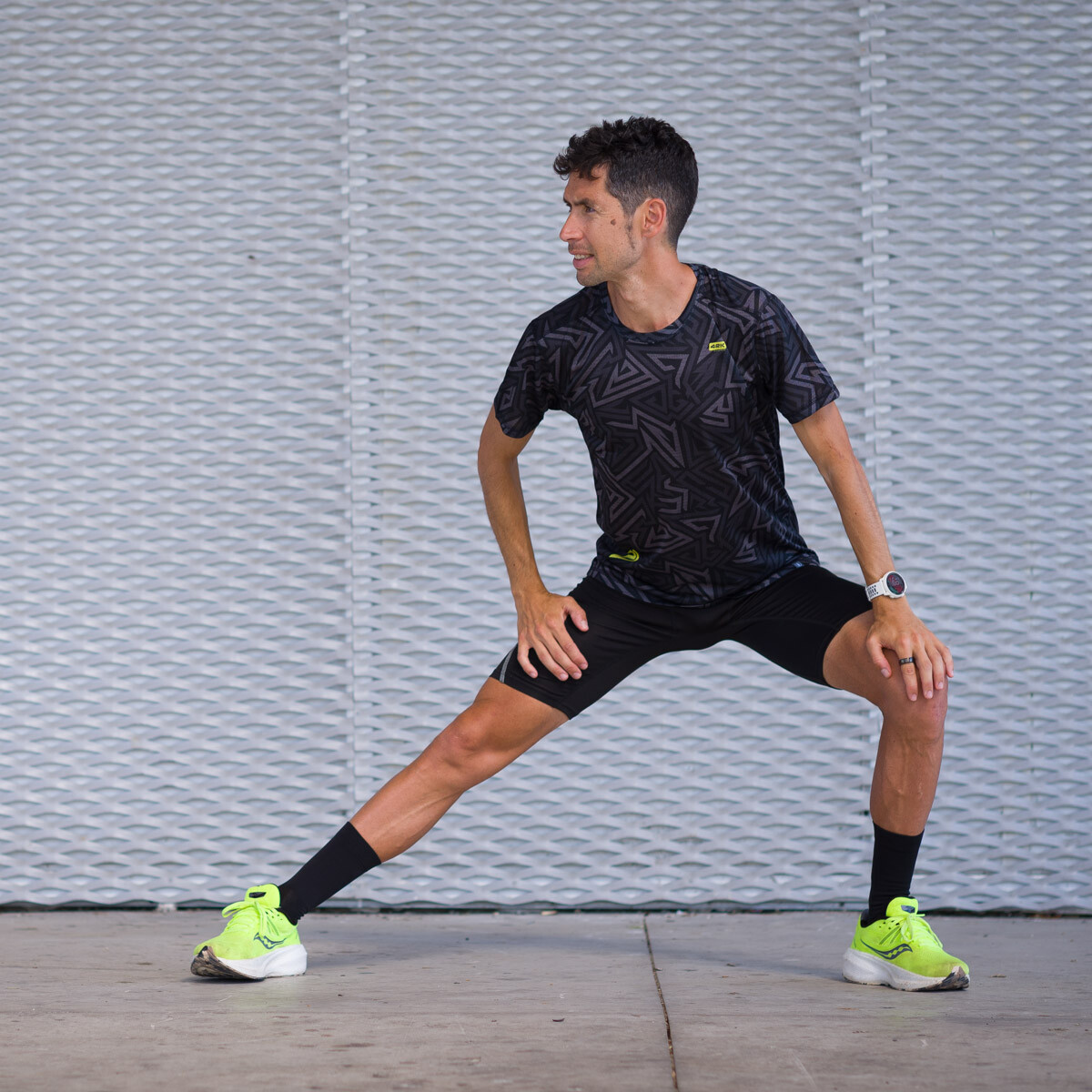
Interval Run. Depending on our objectives we will do a number of repetitions or others during the race, alternating between high intensity intervals and lighter recovery. For example, a runner with a 10K goal might start with a 6 x (2′ + 1′) fartleck doing the 2′ a little faster than the first threshold and easy recovery minute. Instead of going at a rhythm you can also do it by pulse. The ratio of time between intervals and recovery can vary depending on your goals and fitness level.
Variety of rhythms. It can be played with different rhythms and interval durations. You can run short, fast intervals, or longer, moderate intervals.
Varied terrain. If you are an athlete who prepares cross-country, choosing varied terrain (dirt terrain with moderate ups and downs, with curves...) will be very interesting and positive to achieve a good preparation for this modality.
Back to the calm. We will have to finish the session with a phase of lowering heart rate by doing a very light jog of 3'-5'.
Variability. Alternating between fartlek sessions and other types of training, long runs and recovery days is very convenient to maintain a balance in the training program.
Application of fartlek training by levels
Beginners. Beginner runners can start with shorter intervals and longer recovery. This allows you to gradually adapt to the intensity and build a solid base.
Intermediates. Intermediate runners can experiment with different work-to-recovery ratios, progressing to longer, more challenging intervals.
Advanced. Advanced runners can implement the fartlek as part of their weekly training plan. They can incorporate race-specific intervals and simulate competition conditions.
In summary, fartlek training in the running provides wide range of benefitsat improve endurance and speed until developing the mental resistance and the adaptability to different race conditions. Its flexibility and versatility make it an essential tool for runners looking to improve their performance and enjoy variety in their training.
In this article we are going to discuss the tibial periostitis, an injury that any runner should fear because it is causing frequent pain in the tibia, the bone we commonly know as the shin. It is a lsion or pathology typical of runners, mainly for long-distance runners.
Tibial splints is a disabling bone injury, painful and does not heal quickly. Fully recovering from tibial periostitis may require, at a minimum, 50 days without running. It is not surprising, therefore, that anyone who has ever suffered tibial periostitis categorically states that it is a fearsome injury.
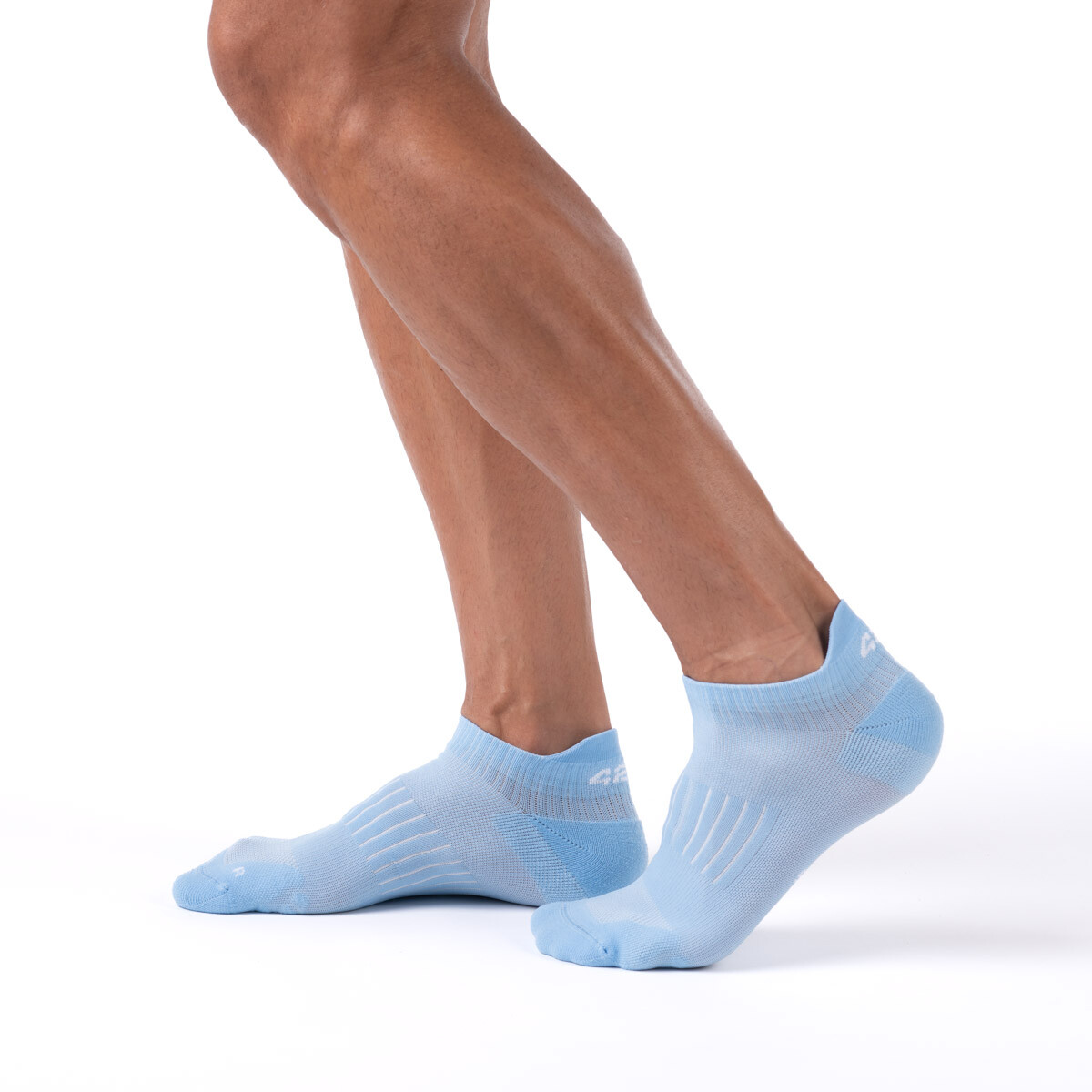
Overtraining, one of the common causes of tibial periostitis
In October comes a very important sporting event for elite athletes but also for thousands of popular runners: the Valencia Half Marathon.
A half marathon, with its just over 21 kilometers, is a distance that already requires specific preparation and that should not be tackled without adequate training. One fact is enough to clearly understand why this is a demanding test: the 21 kilometers and 97 meters of a half marathon involve an average of 42.000 impacts for any runner.
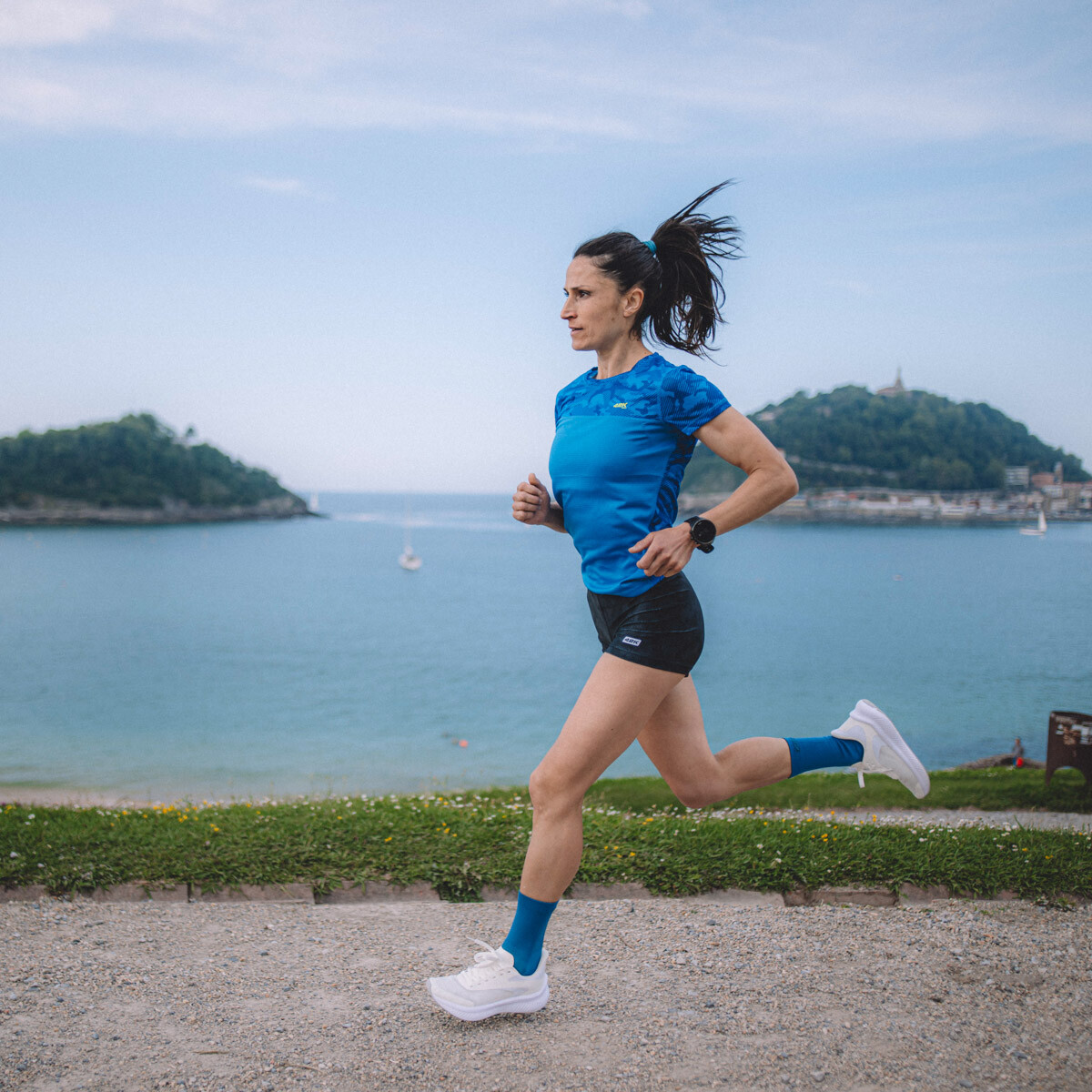
Many runners take part in the Valencia Half Marathon as part of training for the Valencia Marathon, which usually takes place 5 to 6 weeks later.
One of the big mistakes that are made on the way to preparing for a marathon is overtraining or overtraining. And one of the risks of overtraining is suffering from tibial periostitis, a fairly common injury among popular long-distance runners who make the mistake of doing training at high and inappropriate intensities and volumes without having the appropriate muscles for it.
Once again we have to remember the importance of strength work to have the necessary strength and stabilization in the ankles, legs, hips and core muscles to ensure that the legs are prepared to withstand the repetitive stresses and impacts of running.

What is shin splints?
By definition, tibial periostitis (known in medical terms as 'syndrome medial stress of the tibia') is a inflammation of the periosteum, that is, the membrane that covers the tibia on the external surface and unites it with the gastrocnemius, anterior and posterior tibial bones, and peroneal muscles.
The bones have a spongy structure that is designed with trabeculae, whose function is to cushion and redistribute the loads of the impact against the ground, generating a cushioning and force absorption system that will improve biomechanics and shock absorption between bones when the action of running is performed.
Tibial periostitis is caused by inflammation of the membrane that covers the tibia bone, the periosteum. When there is inflammation of the periosteum, poor absorption of loads occurs and microscopic lesion at bone level which can become a fissure or stress fracture. That is, with each impact the bone is injured with the importance it has on a biomechanical and functional level since it is the structure where it has to support all the weight of walking. And also in the structure where all the biomechanical and structural parts of the human body will be joined.
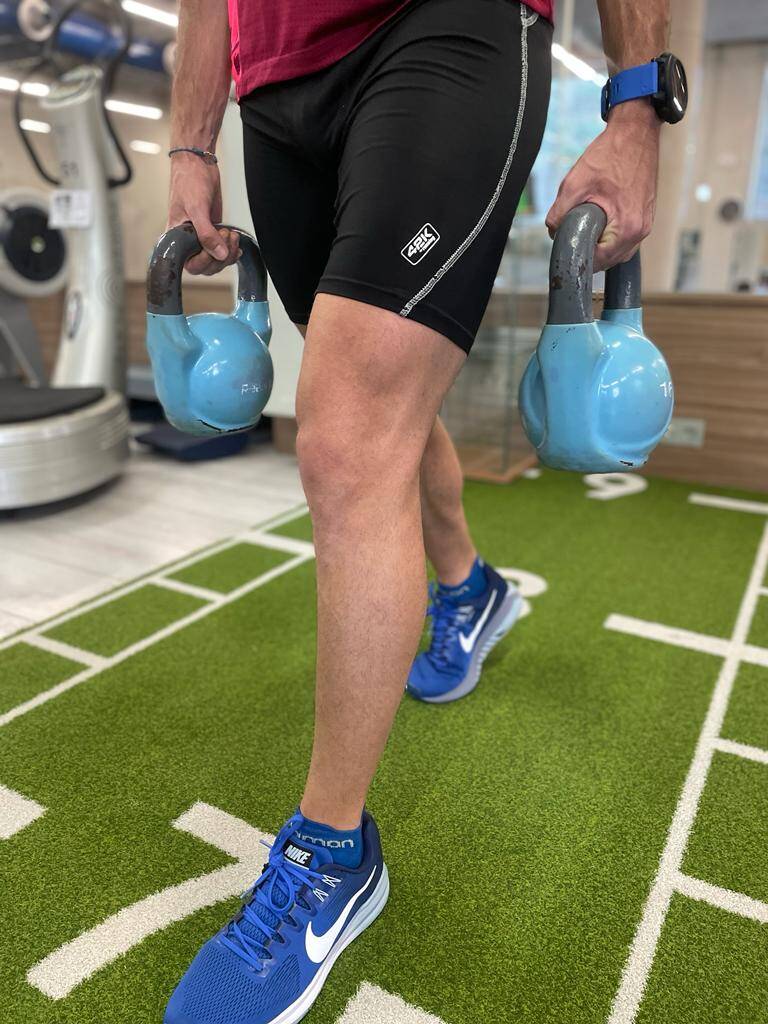
Bone is a living structure and a highly vascularized structure that with each impact that injures your skin will activate metabolic situations that will generate new bone, what we call in the world of sports bone remodeling, which under normal conditions improves and makes stronger the bone but in pathological and inflammatory conditions they damage it.
Tibial periostitis is an injury that begins mildly, with pain in the shinbone(s) when you finish running; Its evolution, if the impact and cushioning are not corrected, causes the pain to become increasingly frequent and bothersome during training and also after training. Tibial periostitis evolves with inflammation and very acute pain on the tibia that becomes so disabling that there are athletes who cannot even walk.
Factors that can influence the appearance of tibial periostitis
Normally, tibial periostitis is indicative of a structural biomechanical problem. It can be the consequence of a short leg, a problem caused during growth or during sports adaptation due to intrinsic factors such as muscle contractures or shortening of muscle chains, which generates what is known in physiotherapy as a short leg. There are also factors such as excessive bone growth in an asymmetrical manner; For example, a person with a longer femur than the other will find that, when absorbing impacts, the short leg assumes more load and this generates pain in the tibial area.
The main factors that can influence the athlete to suffer a loss of cushioning and that this generates tibial periostitis are:
- Athlete above healthy weight or overweight.
- Athlete who suffers from foot disorders, whether valgus or varus, that directly affect the reception of body weight during impact.
- Athlete with a structural biomechanical problem due to having a shorter leg.
- Athlete with poor running technique.
In relation to the 4 previous points, we will now see keys to improve the impact and achieve the necessary re-education so that the tibias can support more load.
- Athlete above healthy weight or with overweight.
- Every athlete must be at their optimal weight and additionally work on strength exercises that improve movement patterns and help the athlete have the strength to endure the competition.
- Athlete suffering from foot disorders whether they are valgus or varus, which directly affect the reception of body weight during impact.
- Every athlete should have a trusted physiotherapist and podiatrist who help improve the intrinsic musculature of the foot and generate a biomechanical study of running and the foot in order to improve impact cushioning through intrinsic work on the foot muscles.
- Athlete with a structural biomechanical problem due to having a shorter leg.
- Generate a biomechanical and radiological study to ensure that the athlete does not have a structural anomaly that quantitatively and qualitatively conditions a real short leg. If you have a real short leg, we will need a podiatrist to generate a template that corrects dysmetria.
- Sportsman with a bad career technique.
- The athlete needs good running technique so that the cushioning process in each impact of the stride during the competition has good load absorption and does not generate inflammation of the tibia that could end in a bone fracture.
Tips to prevent tibial periostitis
My experience as a physiotherapist allows me to indicate the following tips to prevent tibial periostitis.
- Go to the physiotherapist to obtain a biomechanical assessment of the leg and foot in order to find out if there is a structural predisposition to suffer from tibial periostitis.
- Hydrotherapy. Physical work in the water to reduce loads.
- I work with bicycle and elliptical to remove impact.
- Work strength. Work in the gym must be taken very seriously to improve strength patterns and ensure that the muscles are prepared for impacts.
- Improve with a physiotherapist the term muscle in relation to gait patterns.
- Having hip and knee mobility that improve the possibility of ankle impact.
- Remove muscle tension from the tibialis anterior and tibialis posterior which are muscles that directly influence the pressure of the tibia.

Tibial periostitis is an injury that is too often not given due importance with the appearance of the first symptoms. The problem with tibial periostitis is that when it is given importance because the pain is already intense or begins to be disabling, it is when the injury has already entered a phase in which it prevents continuing running because each new impact will worsen.
- Savings pack of 3 ankle socks for running Low Run.
- Fine fabric that provides a comfortable and light fit.
- Made with VAPORFEEL®, very light material and resistant to abrasion and impacts.
- VAPORFEEL® maintains the correct foot temperature and favors a fast drying.
- Composition: 66% VAPORFEEL®, 21% elastic, 11% nylon and 2% lycra.
- Reinforced band on instep for optimal support.
- Reinforcement in toe, sole and heel.
- Zone of grid over fingers for moisture evacuation.
- Logo 42K embroidery on back tab.
- Identification of right foot (R) and left foot (L).
- Size S: 37-39 | Size M: 40-42 | Size L: 43-45.
- Manufactured in Spain.
- Pack of 3 colors: white, black and light sky blue.
- Exclusive online store 42K.
Conservation recommendations:
- Wash maximum at 30º.
- Do not use bleach (bleach or other chemicals)
- Do not iron.
- Do not tumble dry.
- Drying vertically in the shade.
- Do not dry clean.
- Socks ankle braces for running in light sky blue.
- Fine fabric that provides a comfortable and light fit.
- Made with VAPORFEEL®, very light material and resistant to abrasion and impacts.
- VAPORFEEL® maintains the correct foot temperature and favors a fast drying.
- Composition: 66% VAPORFEEL®, 21% elastic, 11% nylon and 2% lycra.
- Reinforced band on instep for optimal support.
- Reinforcement in toe, sole and heel.
- Zone of grid over fingers for moisture evacuation.
- Logo 42K embroidery on back tab.
- Identification of right foot (R) and left foot (L).
- Size S: 37-39 | Size M: 40-42 | Size L: 43-45.
- Manufactured in Spain.
- Available 3 colors: white, black and light sky blue.
- Exclusive online store 42K.
Conservation recommendations:
- Wash maximum at 30º.
- Do not use bleach (bleach or other chemicals)
- Do not iron.
- Do not tumble dry.
- Drying vertically in the shade.
- Do not dry clean.
- Socks ankle braces for running in black.
- Fine fabric that provides a comfortable and light fit.
- Made with VAPORFEEL®, very light material and resistant to abrasion and impacts.
- VAPORFEEL® maintains the correct foot temperature and favors a fast drying.
- Composition: 66% VAPORFEEL®, 21% elastic, 11% nylon and 2% lycra.
- Reinforced band on instep for optimal support.
- Reinforcement in toe, sole and heel.
- Zone of grid over fingers for moisture evacuation.
- Logo 42K embroidery on back tab.
- Identification of right foot (R) and left foot (L).
- Size S: 37-39 | Size M: 40-42 | Size L: 43-45.
- Manufactured in Spain.
- Available 3 colors: white, black and light sky blue.
- Exclusive online store 42K.
Conservation recommendations:
- Wash maximum at 30º.
- Do not use bleach (bleach or other chemicals)
- Do not iron.
- Do not tumble dry.
- Drying vertically in the shade.
- Do not dry clean.
42K · All rights reserved
